Strategy to Reduce Employee Turnover in Aged Care: A Research Project
VerifiedAdded on 2023/06/10
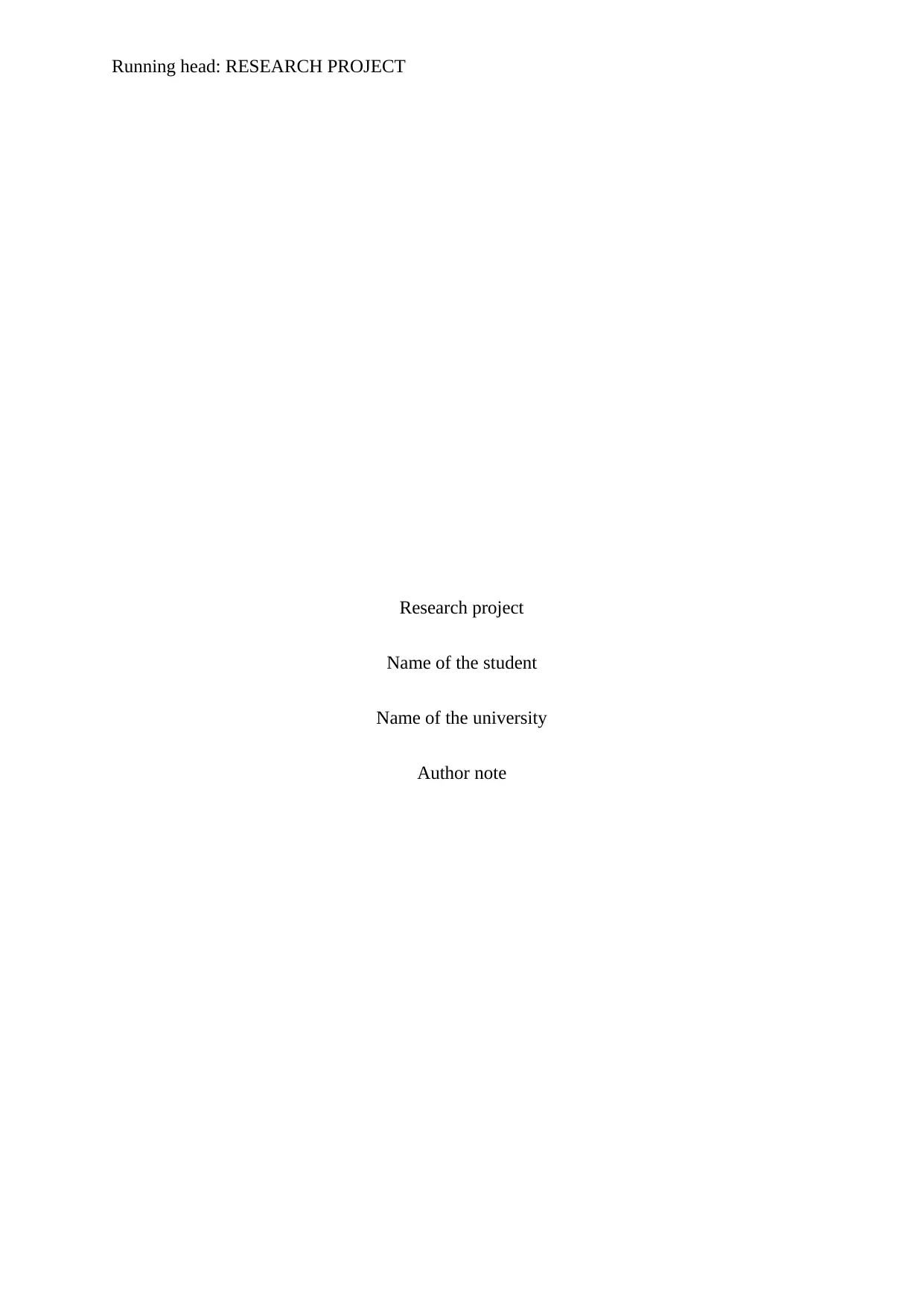
Research project
Name of the student
Name of the university
Author note
Paraphrase This Document
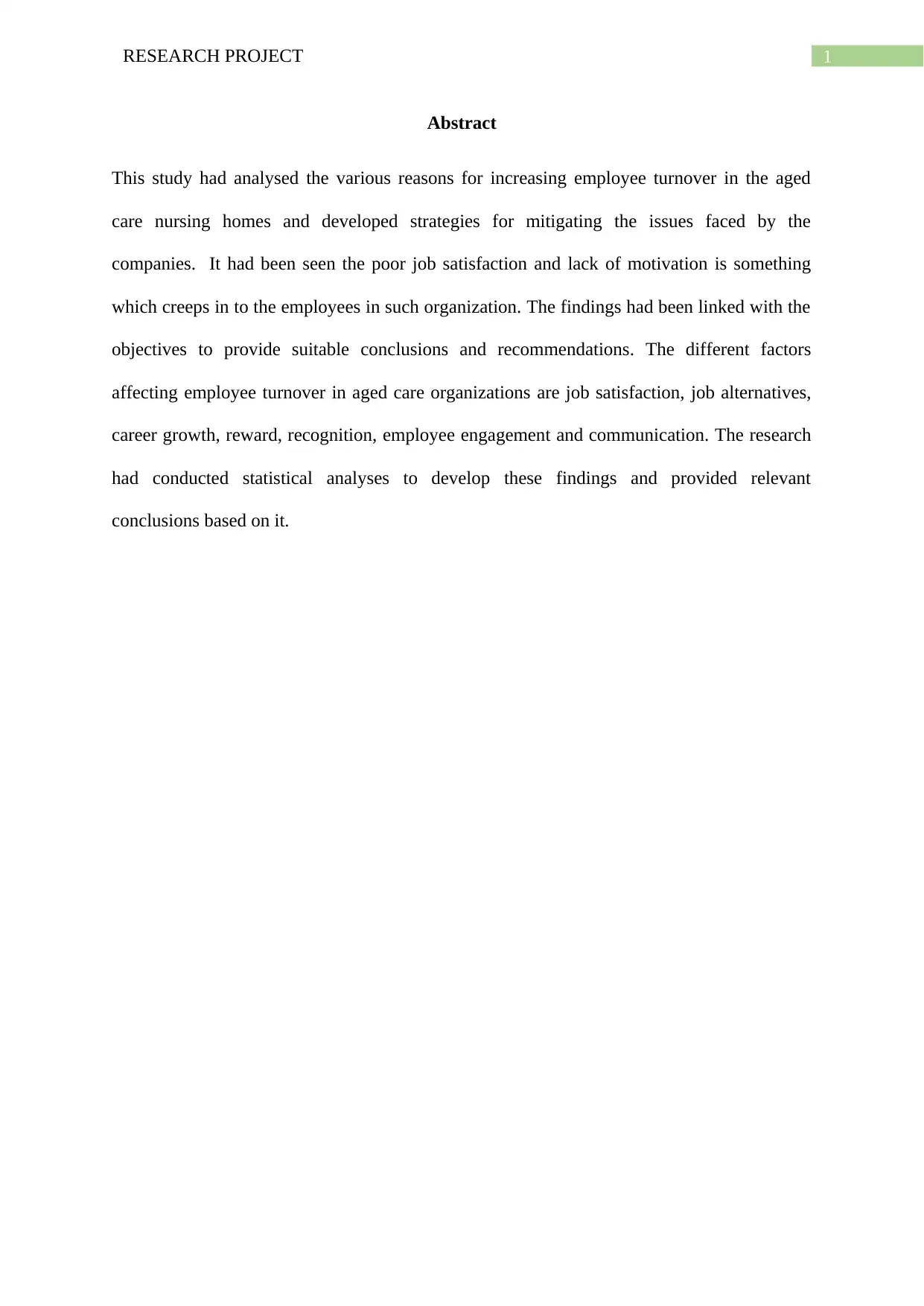
Abstract
This study had analysed the various reasons for increasing employee turnover in the aged
care nursing homes and developed strategies for mitigating the issues faced by the
companies. It had been seen the poor job satisfaction and lack of motivation is something
which creeps in to the employees in such organization. The findings had been linked with the
objectives to provide suitable conclusions and recommendations. The different factors
affecting employee turnover in aged care organizations are job satisfaction, job alternatives,
career growth, reward, recognition, employee engagement and communication. The research
had conducted statistical analyses to develop these findings and provided relevant
conclusions based on it.
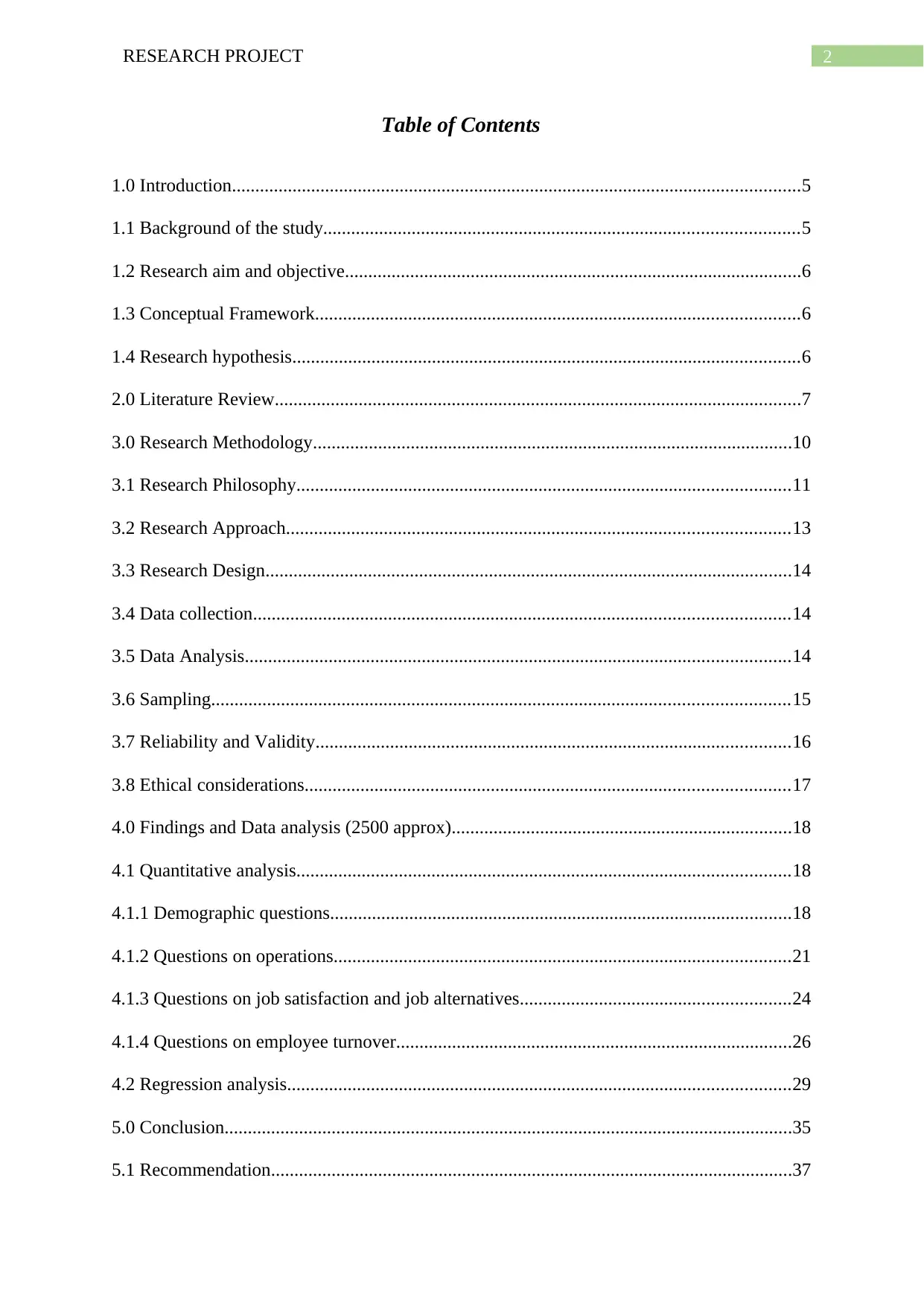
Table of Contents
1.0 Introduction..........................................................................................................................5
1.1 Background of the study......................................................................................................5
1.2 Research aim and objective..................................................................................................6
1.3 Conceptual Framework........................................................................................................6
1.4 Research hypothesis.............................................................................................................6
2.0 Literature Review.................................................................................................................7
3.0 Research Methodology.......................................................................................................10
3.1 Research Philosophy..........................................................................................................11
3.2 Research Approach............................................................................................................13
3.3 Research Design.................................................................................................................14
3.4 Data collection...................................................................................................................14
3.5 Data Analysis.....................................................................................................................14
3.6 Sampling............................................................................................................................15
3.7 Reliability and Validity......................................................................................................16
3.8 Ethical considerations........................................................................................................17
4.0 Findings and Data analysis (2500 approx).........................................................................18
4.1 Quantitative analysis..........................................................................................................18
4.1.1 Demographic questions...................................................................................................18
4.1.2 Questions on operations..................................................................................................21
4.1.3 Questions on job satisfaction and job alternatives..........................................................24
4.1.4 Questions on employee turnover.....................................................................................26
4.2 Regression analysis............................................................................................................29
5.0 Conclusion..........................................................................................................................35
5.1 Recommendation................................................................................................................37
⊘ This is a preview!⊘
Do you want full access?
Subscribe today to unlock all pages.

Trusted by 1+ million students worldwide
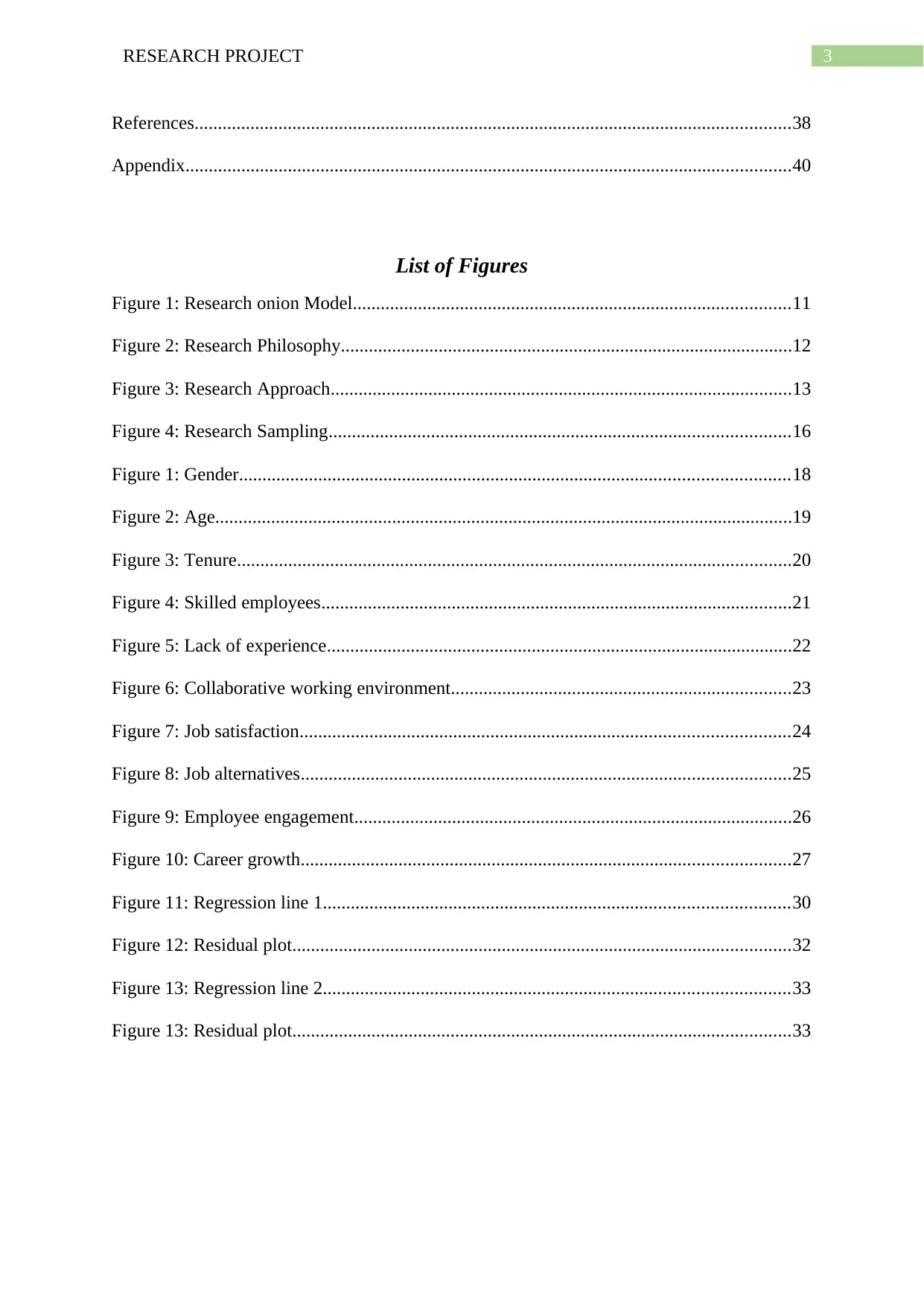
References................................................................................................................................38
Appendix..................................................................................................................................40
List of Figures
Figure 1: Research onion Model..............................................................................................11
Figure 2: Research Philosophy.................................................................................................12
Figure 3: Research Approach...................................................................................................13
Figure 4: Research Sampling...................................................................................................16
Figure 1: Gender......................................................................................................................18
Figure 2: Age............................................................................................................................19
Figure 3: Tenure.......................................................................................................................20
Figure 4: Skilled employees.....................................................................................................21
Figure 5: Lack of experience....................................................................................................22
Figure 6: Collaborative working environment.........................................................................23
Figure 7: Job satisfaction.........................................................................................................24
Figure 8: Job alternatives.........................................................................................................25
Figure 9: Employee engagement..............................................................................................26
Figure 10: Career growth.........................................................................................................27
Figure 11: Regression line 1....................................................................................................30
Figure 12: Residual plot...........................................................................................................32
Figure 13: Regression line 2....................................................................................................33
Figure 13: Residual plot...........................................................................................................33
Paraphrase This Document
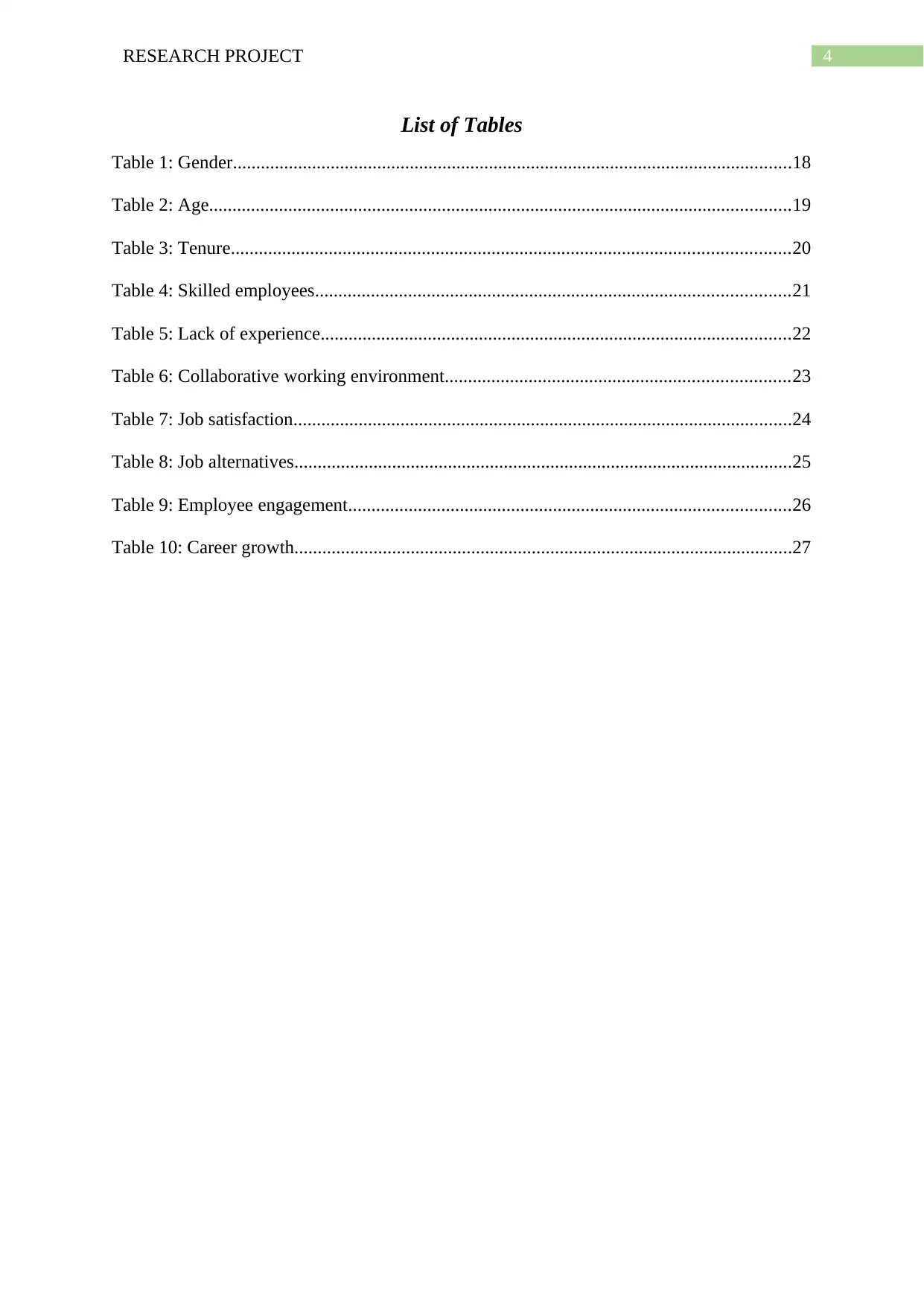
List of Tables
Table 1: Gender........................................................................................................................18
Table 2: Age.............................................................................................................................19
Table 3: Tenure........................................................................................................................20
Table 4: Skilled employees......................................................................................................21
Table 5: Lack of experience.....................................................................................................22
Table 6: Collaborative working environment..........................................................................23
Table 7: Job satisfaction...........................................................................................................24
Table 8: Job alternatives...........................................................................................................25
Table 9: Employee engagement...............................................................................................26
Table 10: Career growth...........................................................................................................27
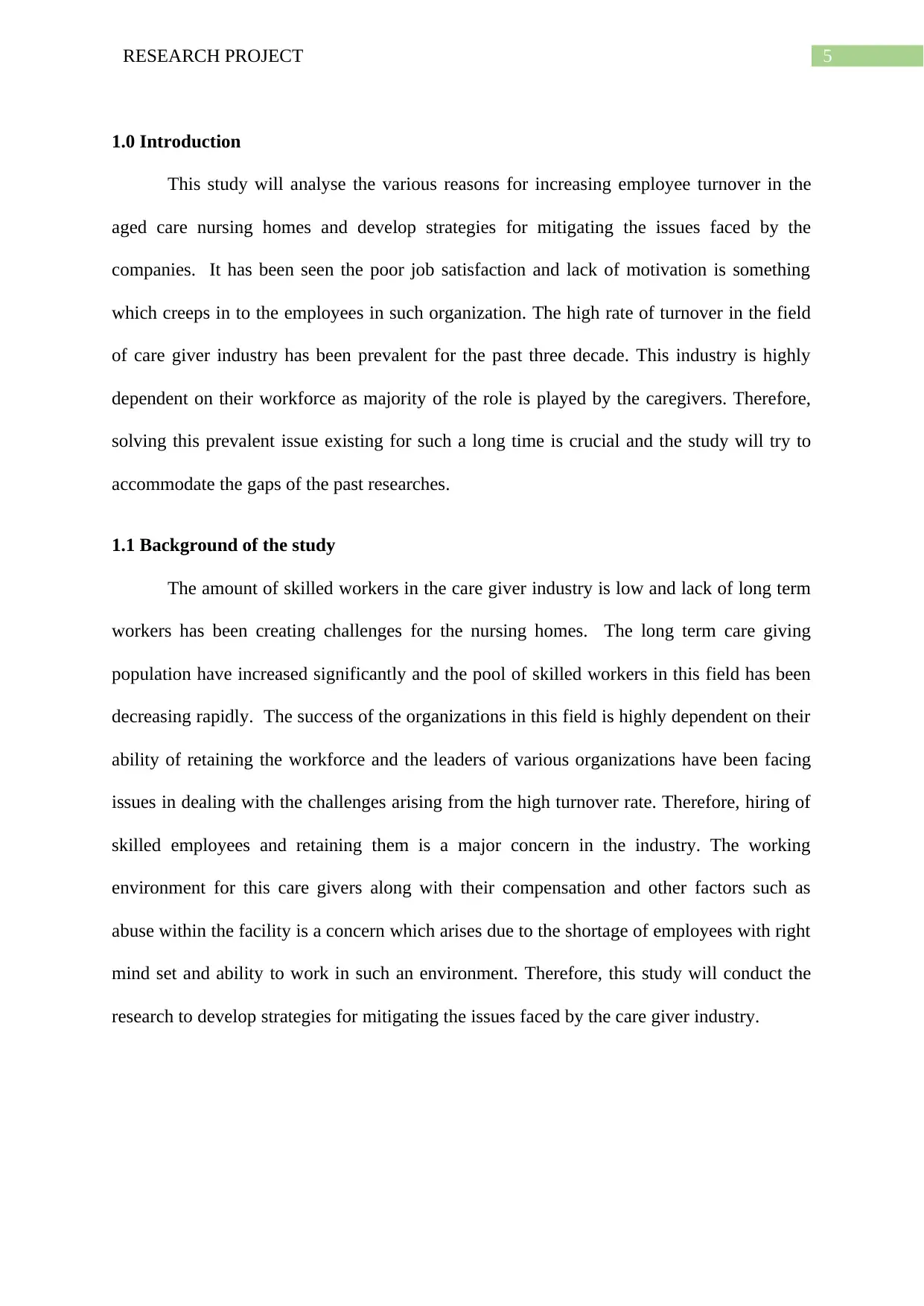
1.0 Introduction
This study will analyse the various reasons for increasing employee turnover in the
aged care nursing homes and develop strategies for mitigating the issues faced by the
companies. It has been seen the poor job satisfaction and lack of motivation is something
which creeps in to the employees in such organization. The high rate of turnover in the field
of care giver industry has been prevalent for the past three decade. This industry is highly
dependent on their workforce as majority of the role is played by the caregivers. Therefore,
solving this prevalent issue existing for such a long time is crucial and the study will try to
accommodate the gaps of the past researches.
1.1 Background of the study
The amount of skilled workers in the care giver industry is low and lack of long term
workers has been creating challenges for the nursing homes. The long term care giving
population have increased significantly and the pool of skilled workers in this field has been
decreasing rapidly. The success of the organizations in this field is highly dependent on their
ability of retaining the workforce and the leaders of various organizations have been facing
issues in dealing with the challenges arising from the high turnover rate. Therefore, hiring of
skilled employees and retaining them is a major concern in the industry. The working
environment for this care givers along with their compensation and other factors such as
abuse within the facility is a concern which arises due to the shortage of employees with right
mind set and ability to work in such an environment. Therefore, this study will conduct the
research to develop strategies for mitigating the issues faced by the care giver industry.
⊘ This is a preview!⊘
Do you want full access?
Subscribe today to unlock all pages.

Trusted by 1+ million students worldwide

1.2 Research aim and objective
The study aims to identify the different factors responsible for high turnover rates in
the care giver industry and nursing. The research will develop mitigation strategies based on
the findings in the study.
The objectives of the study are as follows:
To identify the different factors affecting the employee turnover in aged care
organization
To investigate the impact of high turnover rate in the aged care industry
To recommend suitable strategies to mitigate the issues faced by the employees in the
aged care industry
1.3 Conceptual Framework
1.4 Research hypothesis
H01: Employee turnover does not have any impact on the operations of the age care industry
H11: Employee turnover does have any impact on the operations of the age care industry
Paraphrase This Document
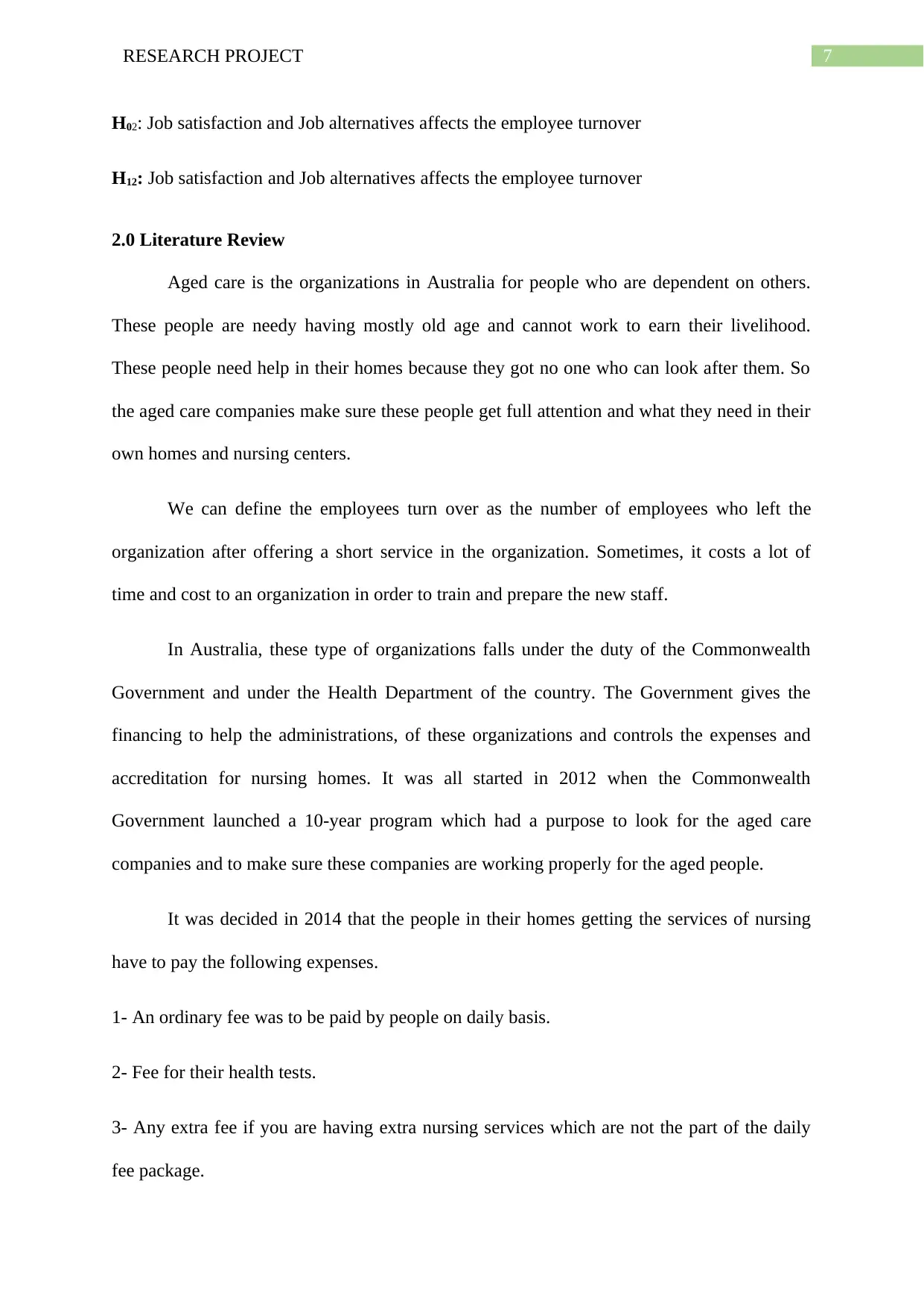
H02: Job satisfaction and Job alternatives affects the employee turnover
H12: Job satisfaction and Job alternatives affects the employee turnover
2.0 Literature Review
Aged care is the organizations in Australia for people who are dependent on others.
These people are needy having mostly old age and cannot work to earn their livelihood.
These people need help in their homes because they got no one who can look after them. So
the aged care companies make sure these people get full attention and what they need in their
own homes and nursing centers.
We can define the employees turn over as the number of employees who left the
organization after offering a short service in the organization. Sometimes, it costs a lot of
time and cost to an organization in order to train and prepare the new staff.
In Australia, these type of organizations falls under the duty of the Commonwealth
Government and under the Health Department of the country. The Government gives the
financing to help the administrations, of these organizations and controls the expenses and
accreditation for nursing homes. It was all started in 2012 when the Commonwealth
Government launched a 10-year program which had a purpose to look for the aged care
companies and to make sure these companies are working properly for the aged people.
It was decided in 2014 that the people in their homes getting the services of nursing
have to pay the following expenses.
1- An ordinary fee was to be paid by people on daily basis.
2- Fee for their health tests.
3- Any extra fee if you are having extra nursing services which are not the part of the daily
fee package.
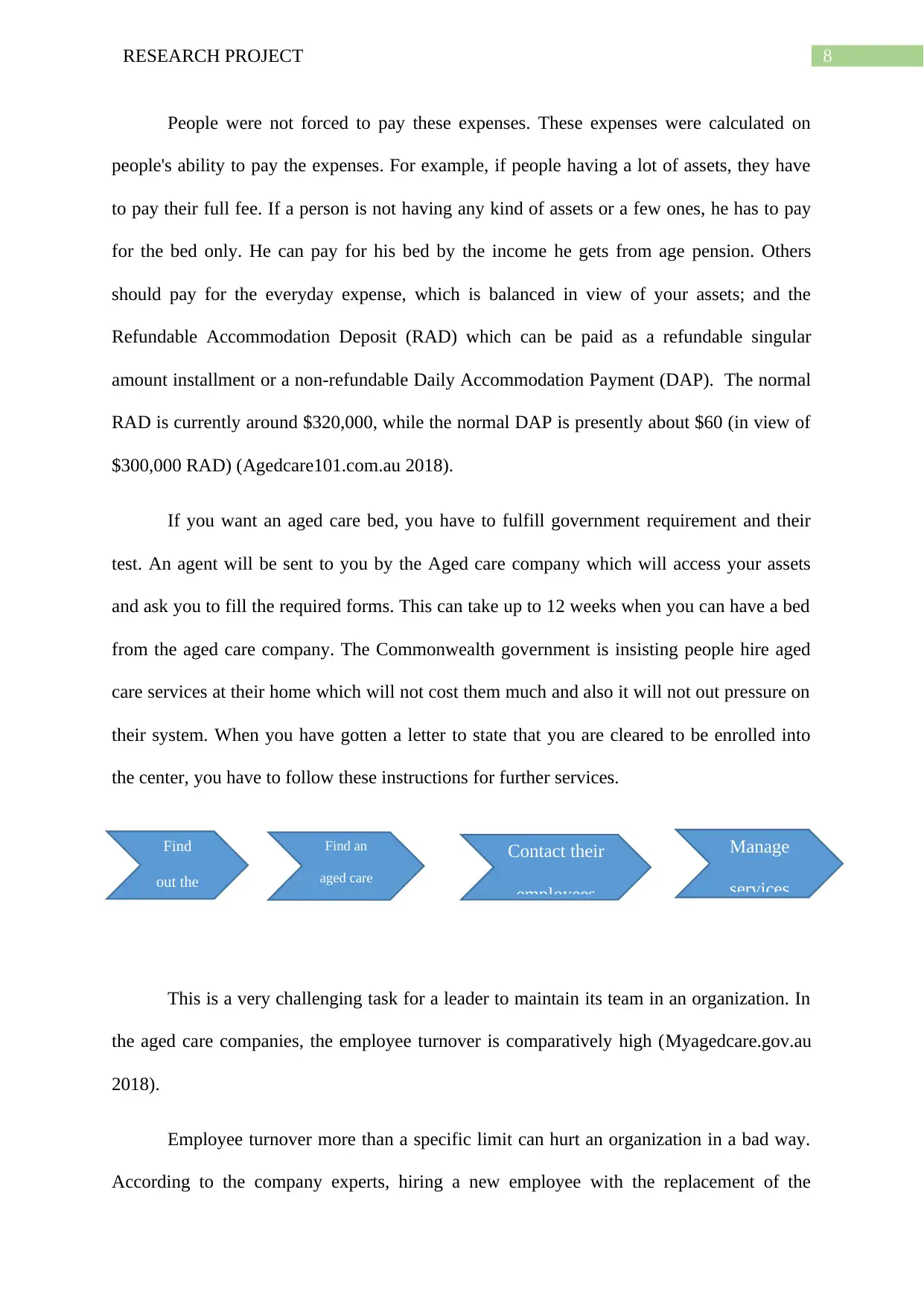
People were not forced to pay these expenses. These expenses were calculated on
people's ability to pay the expenses. For example, if people having a lot of assets, they have
to pay their full fee. If a person is not having any kind of assets or a few ones, he has to pay
for the bed only. He can pay for his bed by the income he gets from age pension. Others
should pay for the everyday expense, which is balanced in view of your assets; and the
Refundable Accommodation Deposit (RAD) which can be paid as a refundable singular
amount installment or a non-refundable Daily Accommodation Payment (DAP). The normal
RAD is currently around $320,000, while the normal DAP is presently about $60 (in view of
$300,000 RAD) (Agedcare101.com.au 2018).
If you want an aged care bed, you have to fulfill government requirement and their
test. An agent will be sent to you by the Aged care company which will access your assets
and ask you to fill the required forms. This can take up to 12 weeks when you can have a bed
from the aged care company. The Commonwealth government is insisting people hire aged
care services at their home which will not cost them much and also it will not out pressure on
their system. When you have gotten a letter to state that you are cleared to be enrolled into
the center, you have to follow these instructions for further services.
This is a very challenging task for a leader to maintain its team in an organization. In
the aged care companies, the employee turnover is comparatively high (Myagedcare.gov.au
2018).
Employee turnover more than a specific limit can hurt an organization in a bad way.
According to the company experts, hiring a new employee with the replacement of the
Find
out the
cost
Find an
aged care
home
Manage
services
Contact their
employees
⊘ This is a preview!⊘
Do you want full access?
Subscribe today to unlock all pages.

Trusted by 1+ million students worldwide

previous one can cost a company a double salary which is spent on the training of the new
employee. People in the twentieth century, including Douglas (1918) and Lescohier (1919),
led the early analysis of the turnover. Douglas discovered that the organization with the high
turnover suffers from the monetary losses while another organization with a lower turnover
of employees suffers from fewer losses. The study of employee turnover the role in an
organization continues in the 21st century and ask more researchers to do studies on it. Many
researchers come up with their theories about the employee turnover. Maertz extends the
results of employee turnover mentioning the costs and budget of a company can increase by
the high percentage of employee turnover and also it lowers the organization's productivity.
The two-factor theory was developed by the Herzberg which focused on the aspects which
can affect the employee turnover and employee’s dissatisfaction with their jobs. The theory
was presented in 1959. The two-factor theory came up with the consequences which
increased the retention of the employees. Gupta and Shaw presented their theory in 2014.
They focused on the employee leadership and mentioned that a motivate leader is necessary
for a successful staff of an organization (Douglas Magazine 2018).
Firth and colleagues is an organization which conducted a research and found that
52% of the reasons which caused the employees to leave the aged care was the stress over the
workplace, the quarrel between employees, company commitment, and the supervisor
behavior. The aged care companies are all about to take care of their people and most of the
staff is female. They have to take care of all of the aged people which is not an easy task to
do. Most of these employees fed up with it due to the strict timing and duty.
For the aged care jobs, they need to attract the younger staff who can bear the hard
work of their duties. Since 90% of the aged care companies staff are females, female workers
age from 18 to 60 are enrolled. Workers above 50 are although mature and experienced
enough to handle the work yet they cannot fulfill the job because sometimes they have to
Paraphrase This Document

travel with people and aged care staff. When an employee left a job in daycare, they have to
enroll a new staff and the new staff requires at least a month for their training. There are a lot
of theories and strategies available which can be followed to attract the aged care employees.
They should be offered a monthly payment which is attracted to them and multiple societal
facilities which can be helpful to them and their family (Guides.wsj.com 2018).
3.0 Research Methodology
The rational way of identifying the different method that will be used for data
collection and analysis is defined in research methodology. The methods, design, approaches
and philosophies will be discussed to outline and portray the clear picture of the appropriate
methods to be used in the study. Specific dogmatic assumptions will be made throughout for
ideal execution of the data collection and analysis. Nature of the study, purpose of the
research, research design and general classification are the different factors which will
have to be taken into account while choosing the appropriate methodology (Flick 2015).
Fundamental research and applied research are the two types that are considered while
taking the nature of the study into account. This particular study is an applied research as it
will address particular problems and issues by the aged care centers due to their high turnover
rate (Mertens 2014). The findings of the study can be used by the managers of the nursing
homes and the different age care centers to mitigate the issued faced by them.
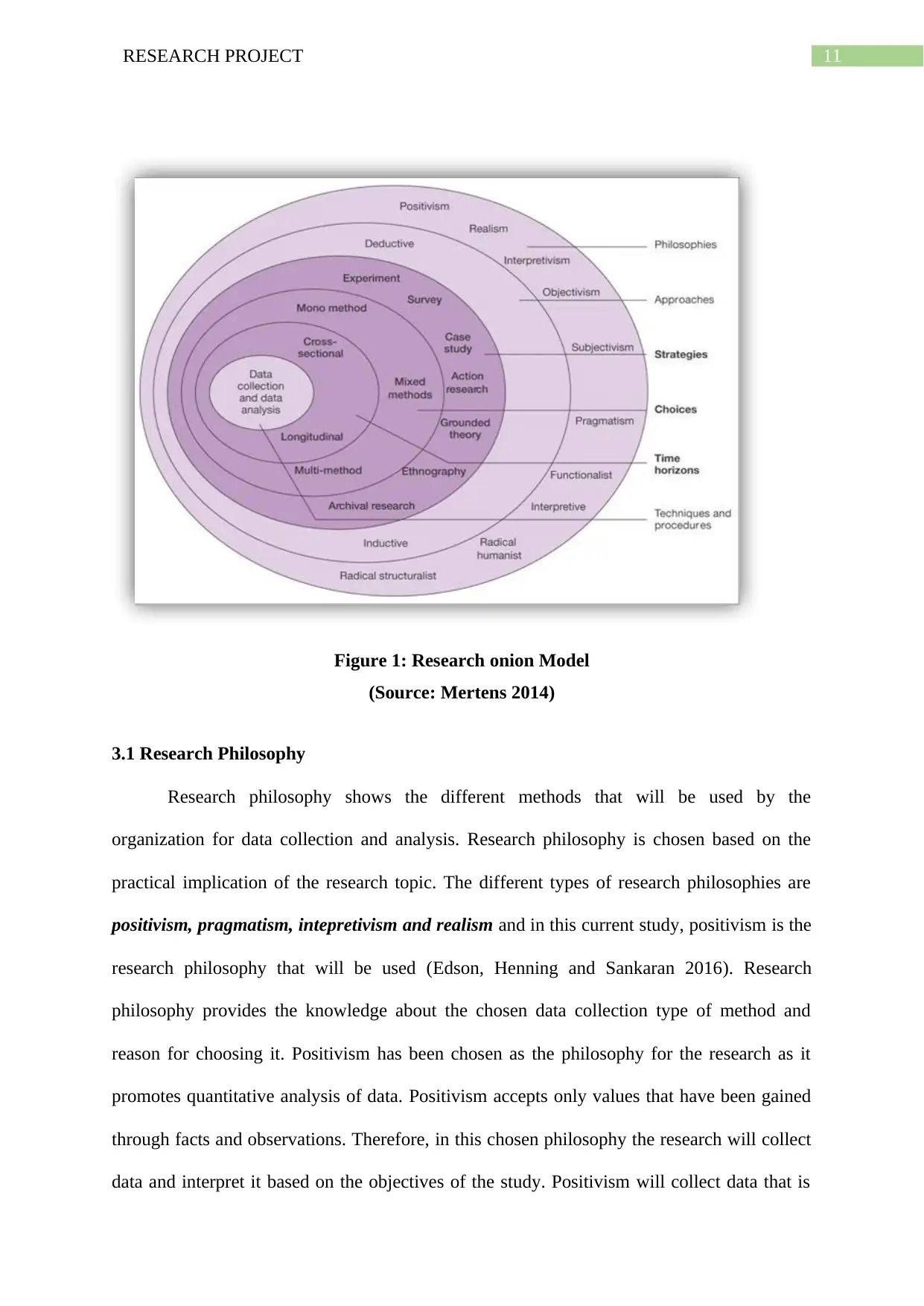
Figure 1: Research onion Model
(Source: Mertens 2014)
3.1 Research Philosophy
Research philosophy shows the different methods that will be used by the
organization for data collection and analysis. Research philosophy is chosen based on the
practical implication of the research topic. The different types of research philosophies are
positivism, pragmatism, intepretivism and realism and in this current study, positivism is the
research philosophy that will be used (Edson, Henning and Sankaran 2016). Research
philosophy provides the knowledge about the chosen data collection type of method and
reason for choosing it. Positivism has been chosen as the philosophy for the research as it
promotes quantitative analysis of data. Positivism accepts only values that have been gained
through facts and observations. Therefore, in this chosen philosophy the research will collect
data and interpret it based on the objectives of the study. Positivism will collect data that is
⊘ This is a preview!⊘
Do you want full access?
Subscribe today to unlock all pages.

Trusted by 1+ million students worldwide
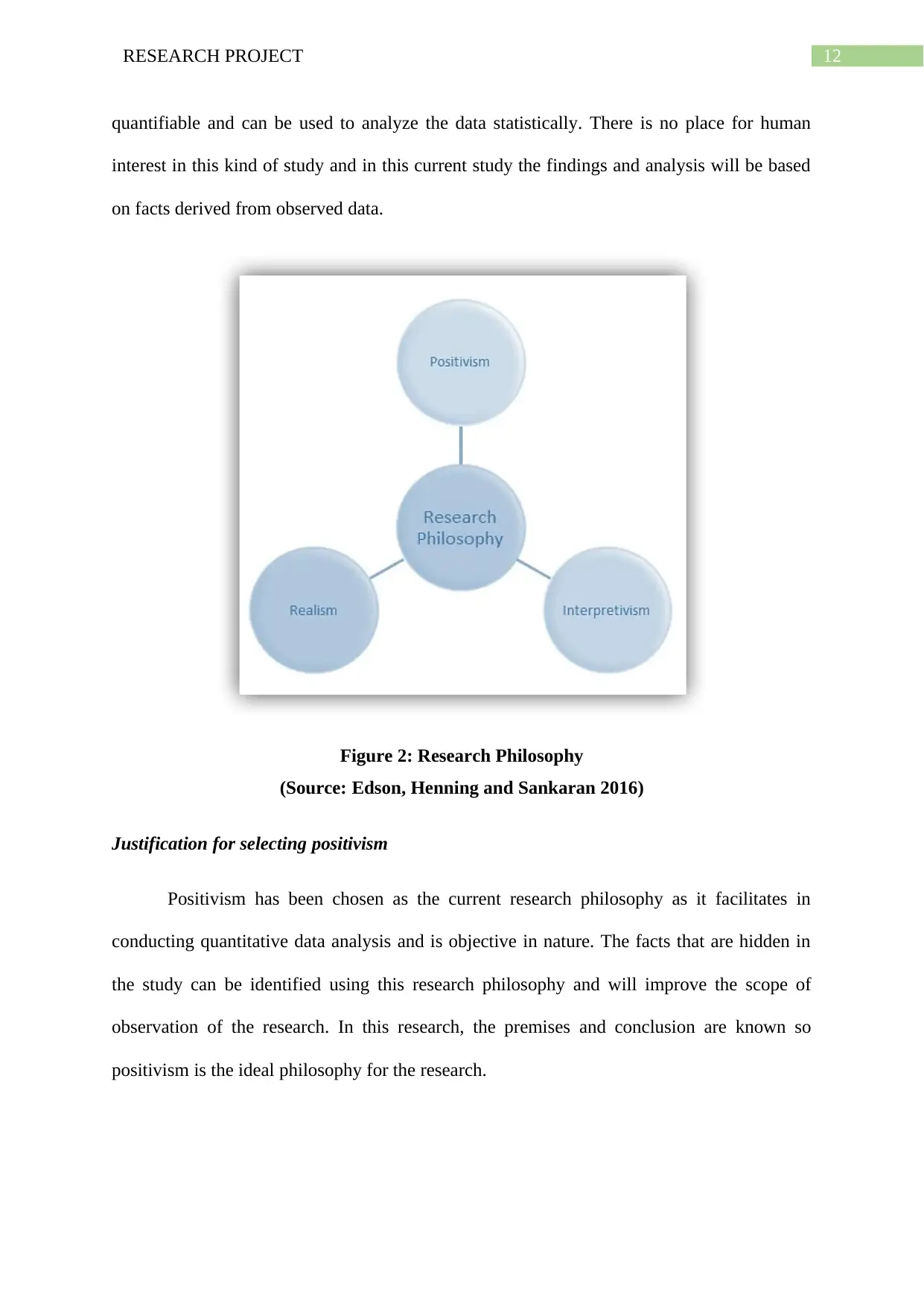
quantifiable and can be used to analyze the data statistically. There is no place for human
interest in this kind of study and in this current study the findings and analysis will be based
on facts derived from observed data.
Figure 2: Research Philosophy
(Source: Edson, Henning and Sankaran 2016)
Justification for selecting positivism
Positivism has been chosen as the current research philosophy as it facilitates in
conducting quantitative data analysis and is objective in nature. The facts that are hidden in
the study can be identified using this research philosophy and will improve the scope of
observation of the research. In this research, the premises and conclusion are known so
positivism is the ideal philosophy for the research.
Paraphrase This Document

3.2 Research Approach
Deductive, inductive and abductive are the three types of research approaches used in
academic studies. The difference between the inductive and the deductive approach can be
identified by the relevance of hypothesis in the study (Sekaran and Bougie 2016). In
abductive approach, initially shocking facts are presented and these are validated by
providing relevant justifications. Deductive approach is used to prove the existing theories by
developing hypothesis based on the literature review. In inductive approach, the literature
review and data collection is explored to develop tentative hypothesis. This means that new
theories and generalizations are formed by using the inductive approach. However, in this
current study the chosen and appropriate research is deductive approach.
Figure 3: Research Approach
(Source: Sekaran and Bougie 2016)
Justification for selecting the deductive approach
Deductive approach will be able to validate the existing theories in the study where
the developed hypothesis will be tested using statistical methods. The deductive approach as
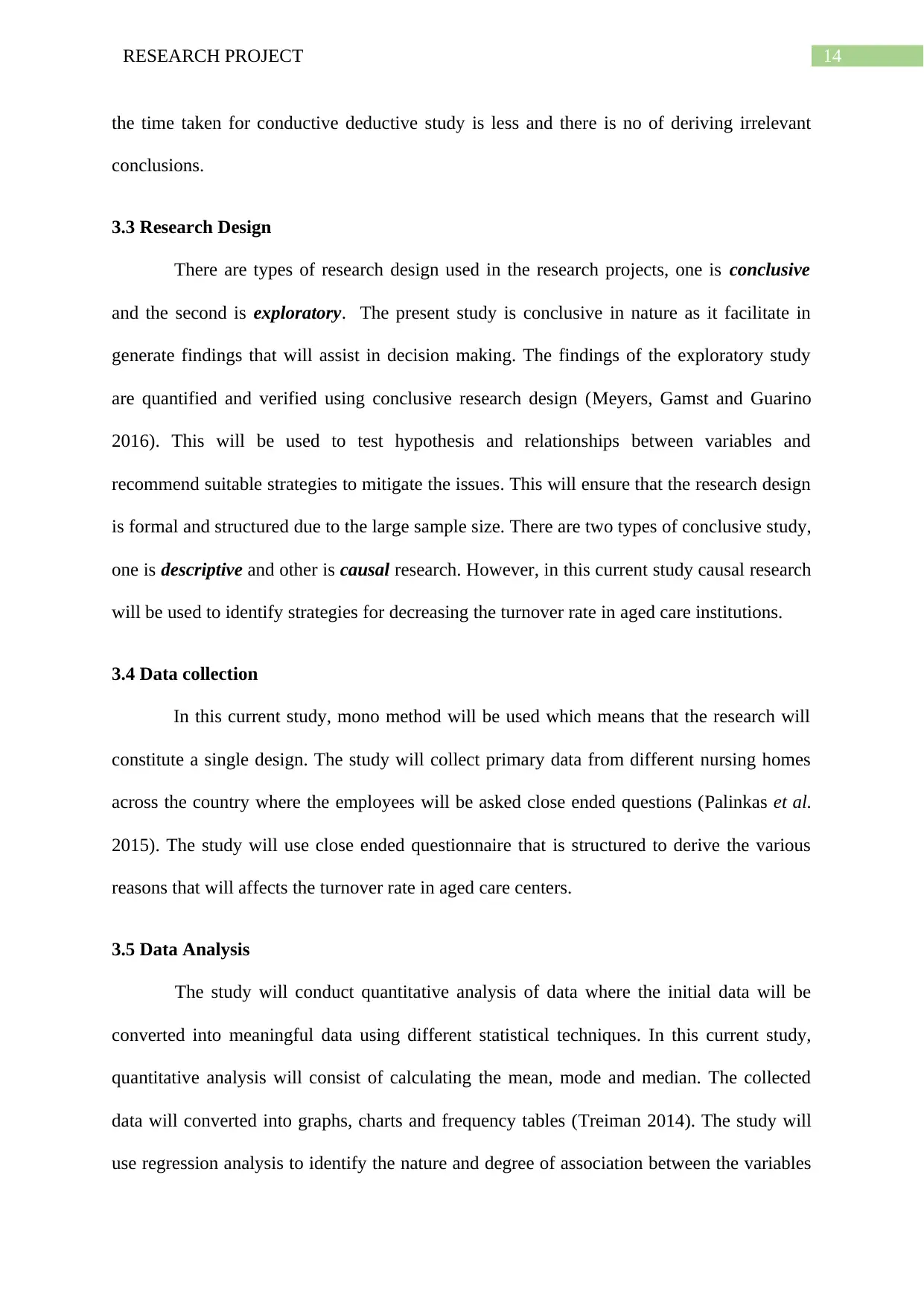
the time taken for conductive deductive study is less and there is no of deriving irrelevant
conclusions.
3.3 Research Design
There are types of research design used in the research projects, one is conclusive
and the second is exploratory. The present study is conclusive in nature as it facilitate in
generate findings that will assist in decision making. The findings of the exploratory study
are quantified and verified using conclusive research design (Meyers, Gamst and Guarino
2016). This will be used to test hypothesis and relationships between variables and
recommend suitable strategies to mitigate the issues. This will ensure that the research design
is formal and structured due to the large sample size. There are two types of conclusive study,
one is descriptive and other is causal research. However, in this current study causal research
will be used to identify strategies for decreasing the turnover rate in aged care institutions.
3.4 Data collection
In this current study, mono method will be used which means that the research will
constitute a single design. The study will collect primary data from different nursing homes
across the country where the employees will be asked close ended questions (Palinkas et al.
2015). The study will use close ended questionnaire that is structured to derive the various
reasons that will affects the turnover rate in aged care centers.
3.5 Data Analysis
The study will conduct quantitative analysis of data where the initial data will be
converted into meaningful data using different statistical techniques. In this current study,
quantitative analysis will consist of calculating the mean, mode and median. The collected
data will converted into graphs, charts and frequency tables (Treiman 2014). The study will
use regression analysis to identify the nature and degree of association between the variables
⊘ This is a preview!⊘
Do you want full access?
Subscribe today to unlock all pages.

Trusted by 1+ million students worldwide

in the study. The relationship between the variables will determine the strategies that can be
used by the nursing homes to make improvements to the turnover rate.
3.6 Sampling
In research, taking the whole population into account to derive findings is difficult
and it is difficult to calculate these findings effectively. Moreover, analysing large number of
data variables increases the time span and the cost of the research. Sampling will select
population from the total population. Probabilistic and non-probabilistic sampling are the
two methods used to select respondents for the study. In this current study, probabilistic
sampling will be used which is based on randomization of the data and simple random
sampling will be used to collect respondents (Dobson, Woller-Skar and Green 2017). This
will provide the opportunity to the overall population of being chosen for the study. In this
present study, initially data have been collected from 300 respondents and simple random
sampling has been used to narrow down the respondents to 150. The employees from the
different nursing centres has been taken as the respondents for the study.
Paraphrase This Document
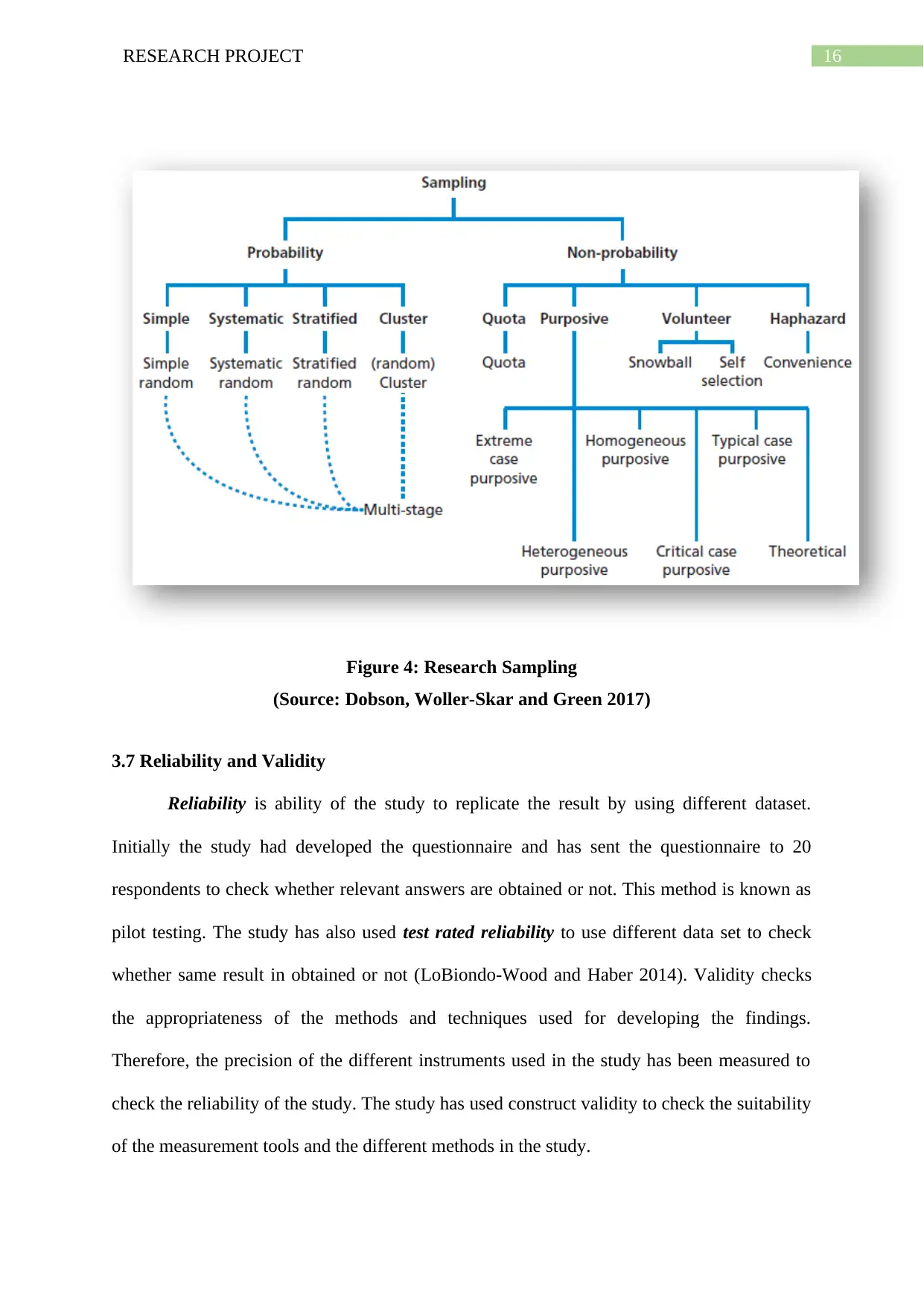
Figure 4: Research Sampling
(Source: Dobson, Woller-Skar and Green 2017)
3.7 Reliability and Validity
Reliability is ability of the study to replicate the result by using different dataset.
Initially the study had developed the questionnaire and has sent the questionnaire to 20
respondents to check whether relevant answers are obtained or not. This method is known as
pilot testing. The study has also used test rated reliability to use different data set to check
whether same result in obtained or not (LoBiondo-Wood and Haber 2014). Validity checks
the appropriateness of the methods and techniques used for developing the findings.
Therefore, the precision of the different instruments used in the study has been measured to
check the reliability of the study. The study has used construct validity to check the suitability
of the measurement tools and the different methods in the study.
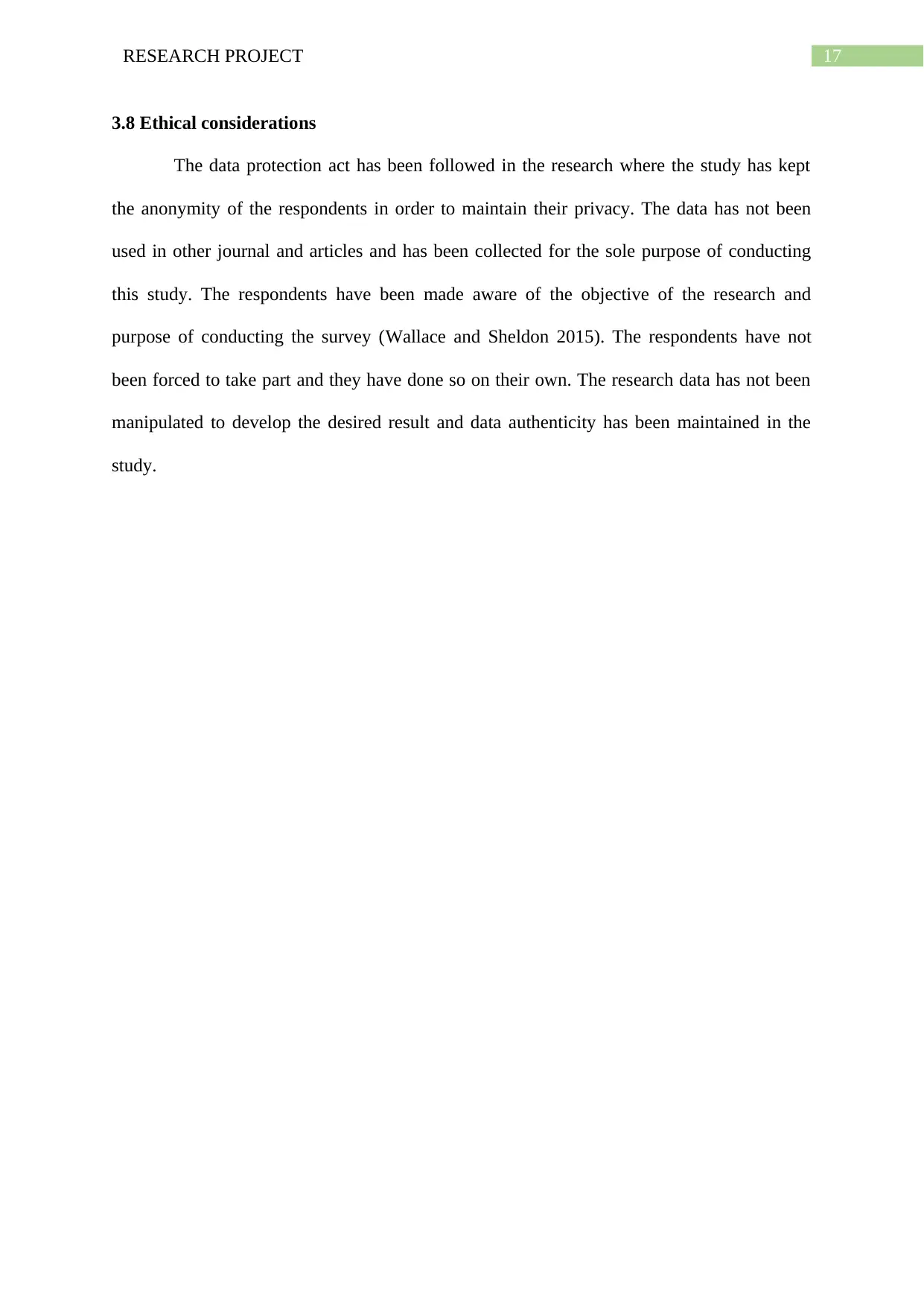
3.8 Ethical considerations
The data protection act has been followed in the research where the study has kept
the anonymity of the respondents in order to maintain their privacy. The data has not been
used in other journal and articles and has been collected for the sole purpose of conducting
this study. The respondents have been made aware of the objective of the research and
purpose of conducting the survey (Wallace and Sheldon 2015). The respondents have not
been forced to take part and they have done so on their own. The research data has not been
manipulated to develop the desired result and data authenticity has been maintained in the
study.
⊘ This is a preview!⊘
Do you want full access?
Subscribe today to unlock all pages.

Trusted by 1+ million students worldwide
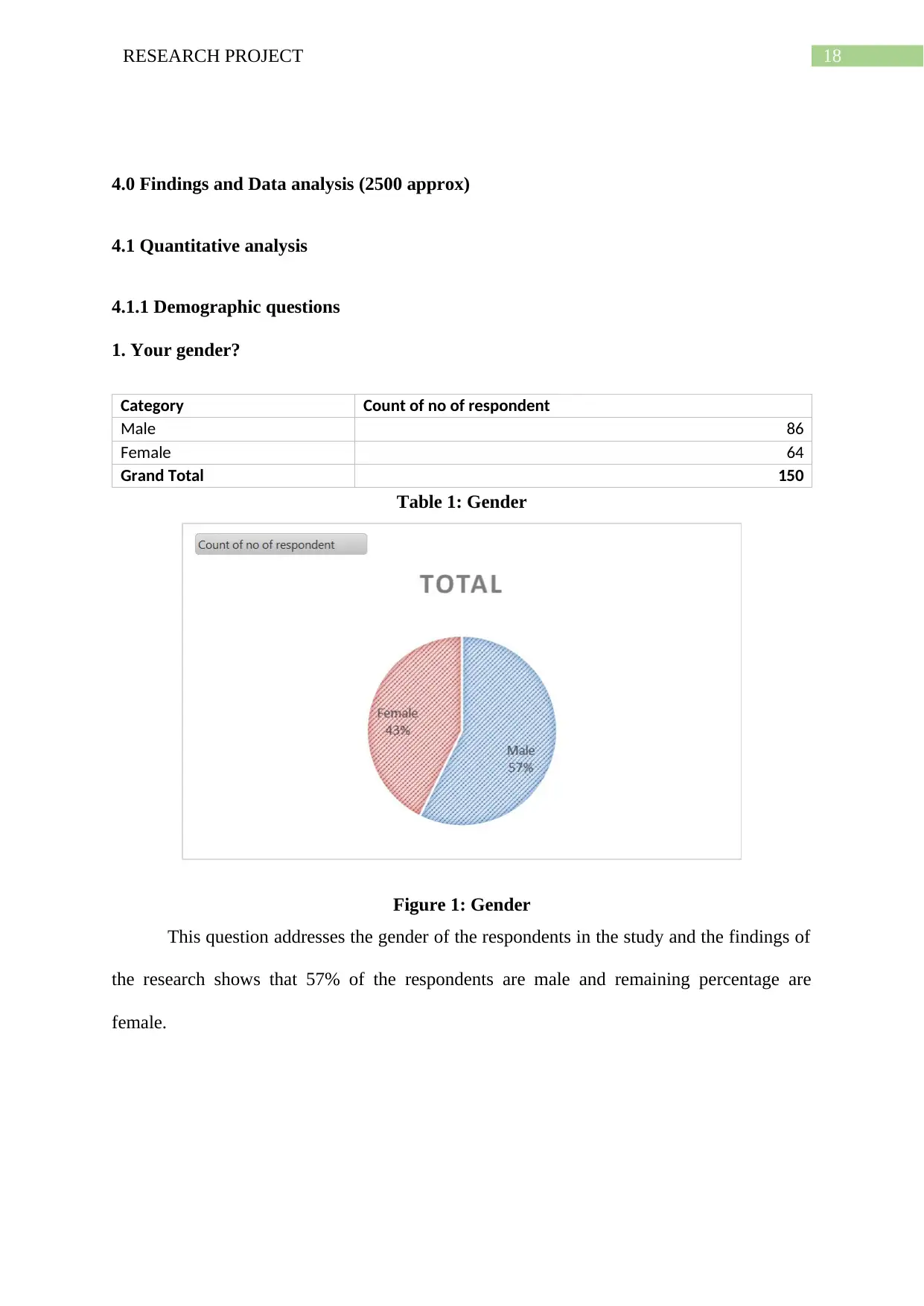
4.0 Findings and Data analysis (2500 approx)
4.1 Quantitative analysis
4.1.1 Demographic questions
1. Your gender?
Category Count of no of respondent
Male 86
Female 64
Grand Total 150
Table 1: Gender
Figure 1: Gender
This question addresses the gender of the respondents in the study and the findings of
the research shows that 57% of the respondents are male and remaining percentage are
female.
Paraphrase This Document
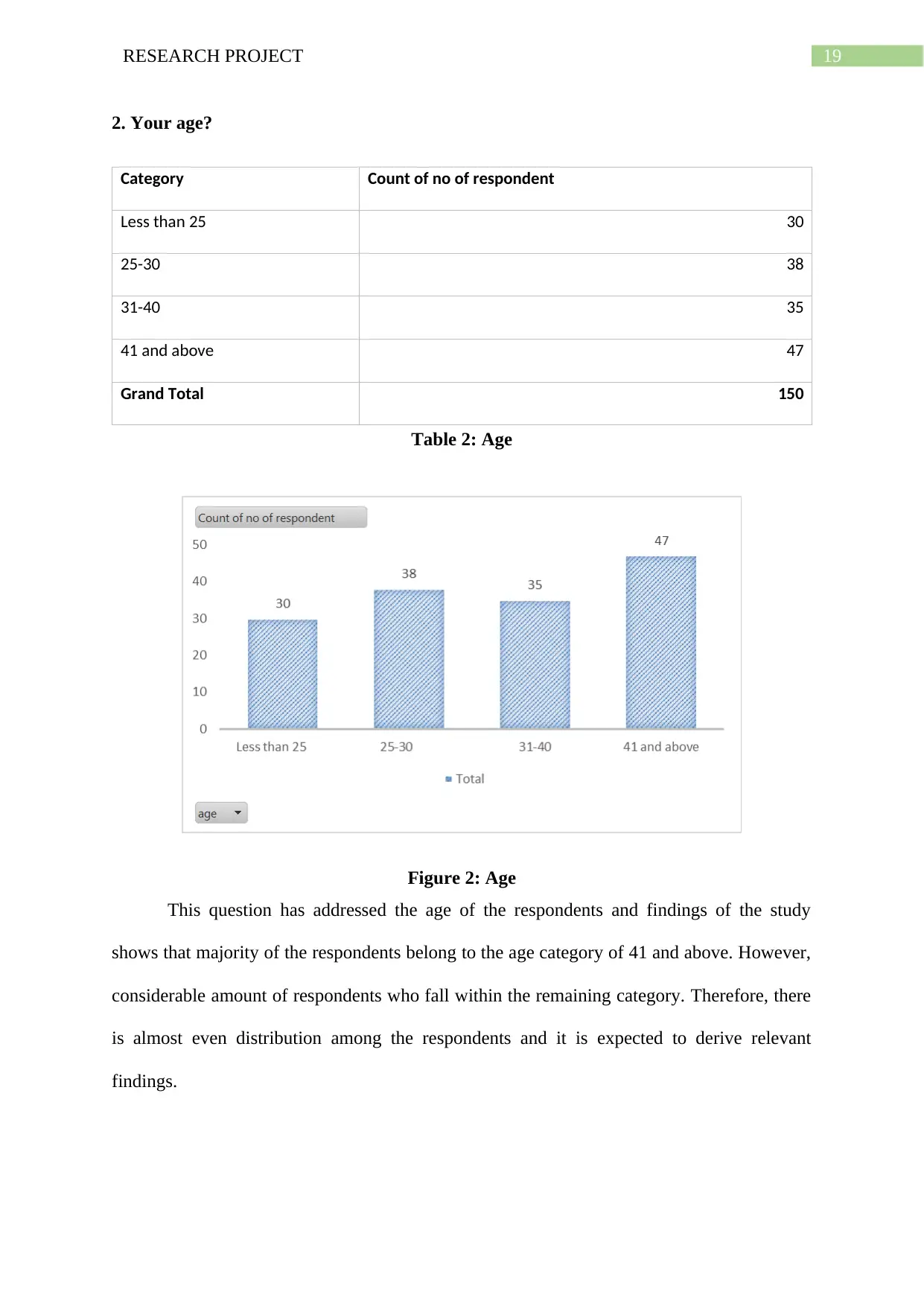
2. Your age?
Category Count of no of respondent
Less than 25 30
25-30 38
31-40 35
41 and above 47
Grand Total 150
Table 2: Age
Figure 2: Age
This question has addressed the age of the respondents and findings of the study
shows that majority of the respondents belong to the age category of 41 and above. However,
considerable amount of respondents who fall within the remaining category. Therefore, there
is almost even distribution among the respondents and it is expected to derive relevant
findings.

⊘ This is a preview!⊘
Do you want full access?
Subscribe today to unlock all pages.

Trusted by 1+ million students worldwide
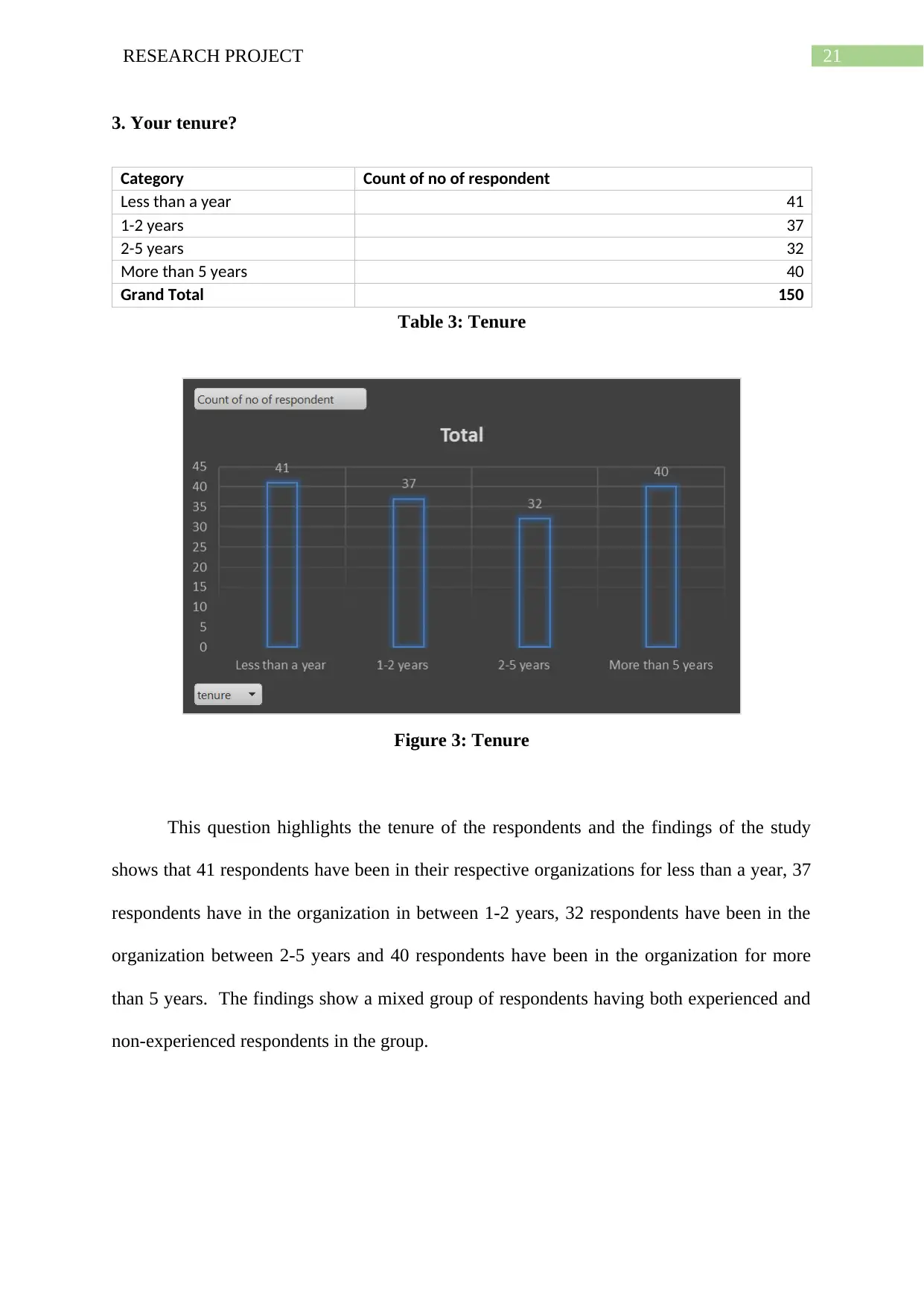
3. Your tenure?
Category Count of no of respondent
Less than a year 41
1-2 years 37
2-5 years 32
More than 5 years 40
Grand Total 150
Table 3: Tenure
Figure 3: Tenure
This question highlights the tenure of the respondents and the findings of the study
shows that 41 respondents have been in their respective organizations for less than a year, 37
respondents have in the organization in between 1-2 years, 32 respondents have been in the
organization between 2-5 years and 40 respondents have been in the organization for more
than 5 years. The findings show a mixed group of respondents having both experienced and
non-experienced respondents in the group.
Paraphrase This Document
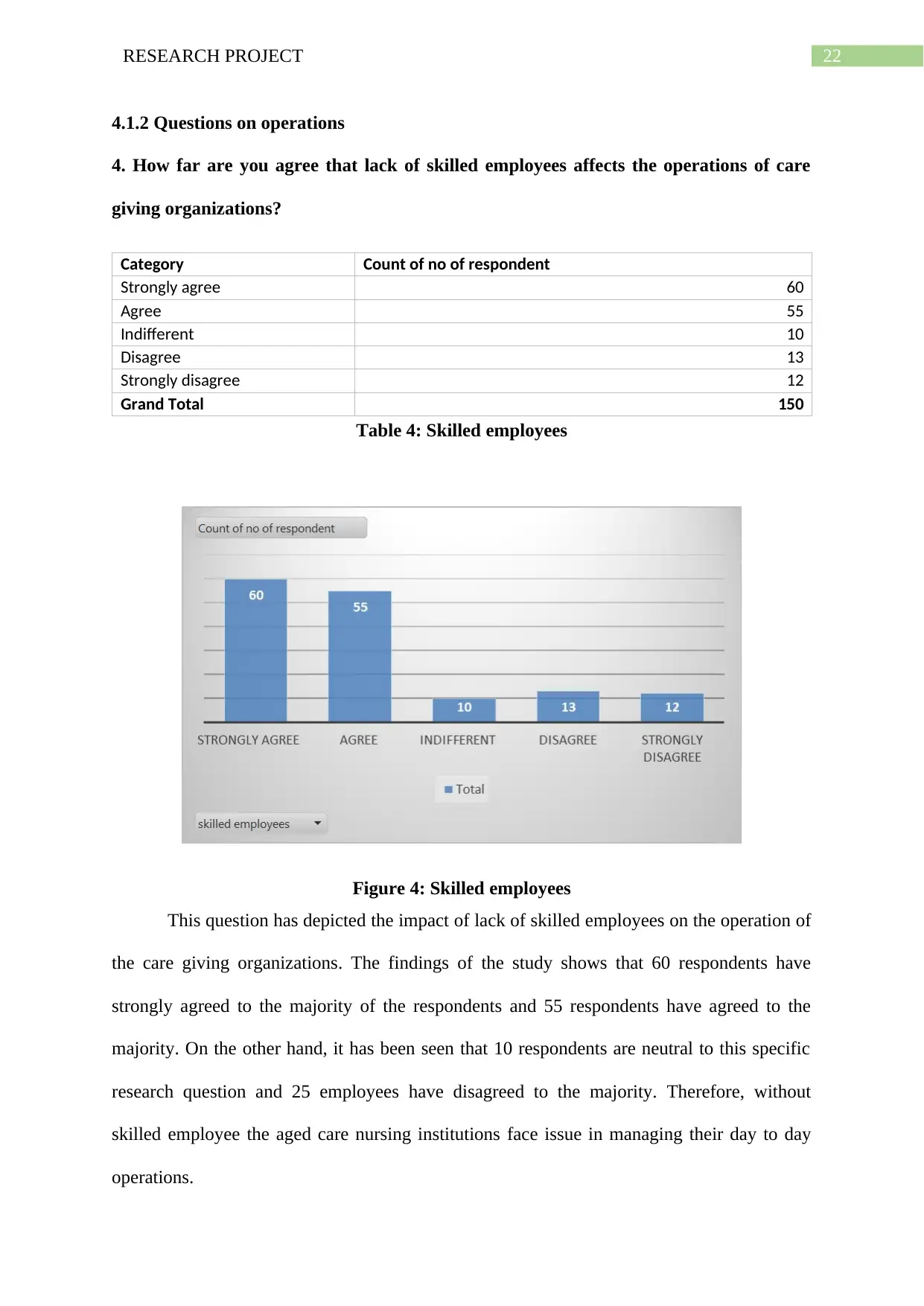
4.1.2 Questions on operations
4. How far are you agree that lack of skilled employees affects the operations of care
giving organizations?
Category Count of no of respondent
Strongly agree 60
Agree 55
Indifferent 10
Disagree 13
Strongly disagree 12
Grand Total 150
Table 4: Skilled employees
Figure 4: Skilled employees
This question has depicted the impact of lack of skilled employees on the operation of
the care giving organizations. The findings of the study shows that 60 respondents have
strongly agreed to the majority of the respondents and 55 respondents have agreed to the
majority. On the other hand, it has been seen that 10 respondents are neutral to this specific
research question and 25 employees have disagreed to the majority. Therefore, without
skilled employee the aged care nursing institutions face issue in managing their day to day
operations.
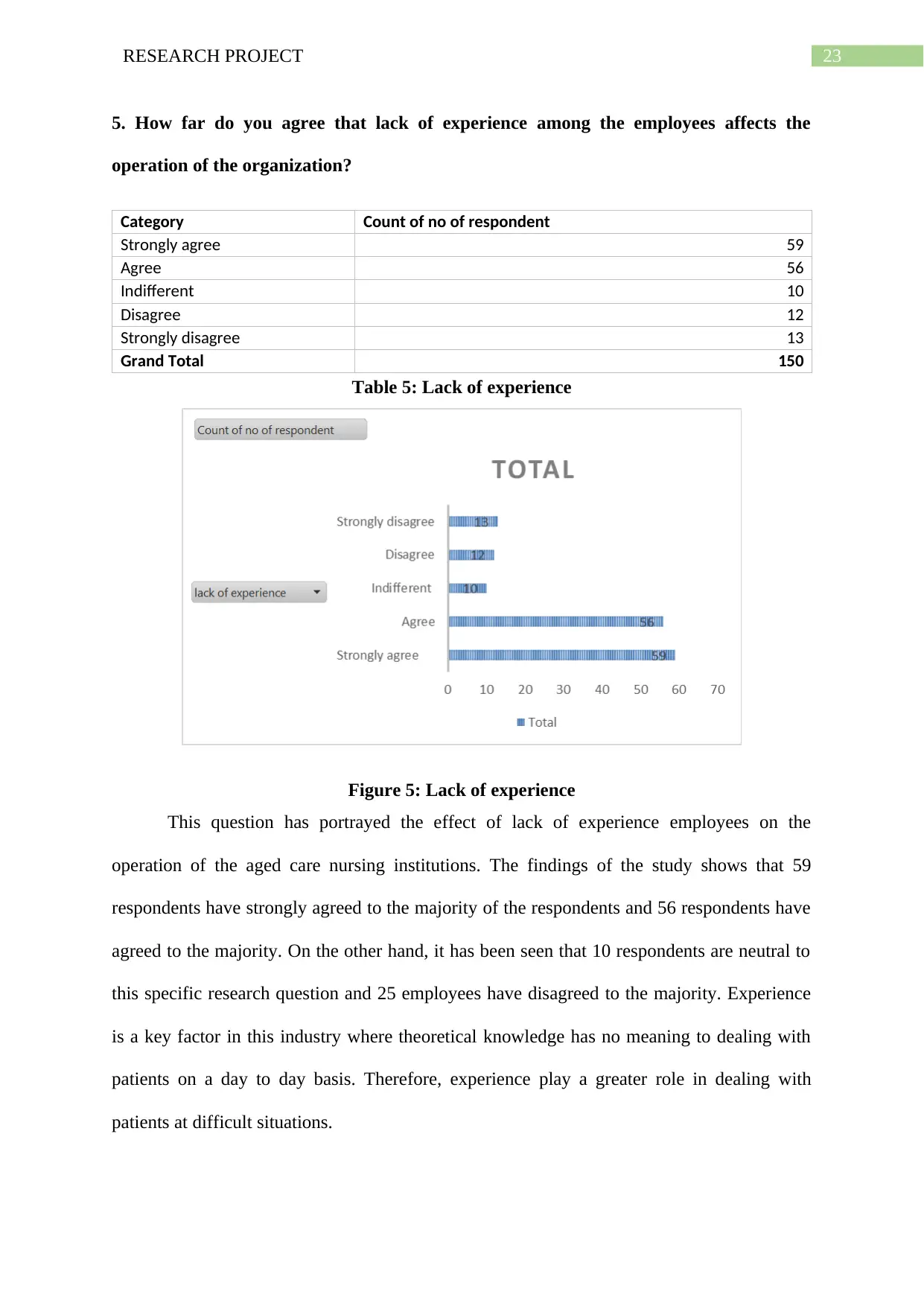
5. How far do you agree that lack of experience among the employees affects the
operation of the organization?
Category Count of no of respondent
Strongly agree 59
Agree 56
Indifferent 10
Disagree 12
Strongly disagree 13
Grand Total 150
Table 5: Lack of experience
Figure 5: Lack of experience
This question has portrayed the effect of lack of experience employees on the
operation of the aged care nursing institutions. The findings of the study shows that 59
respondents have strongly agreed to the majority of the respondents and 56 respondents have
agreed to the majority. On the other hand, it has been seen that 10 respondents are neutral to
this specific research question and 25 employees have disagreed to the majority. Experience
is a key factor in this industry where theoretical knowledge has no meaning to dealing with
patients on a day to day basis. Therefore, experience play a greater role in dealing with
patients at difficult situations.
⊘ This is a preview!⊘
Do you want full access?
Subscribe today to unlock all pages.

Trusted by 1+ million students worldwide
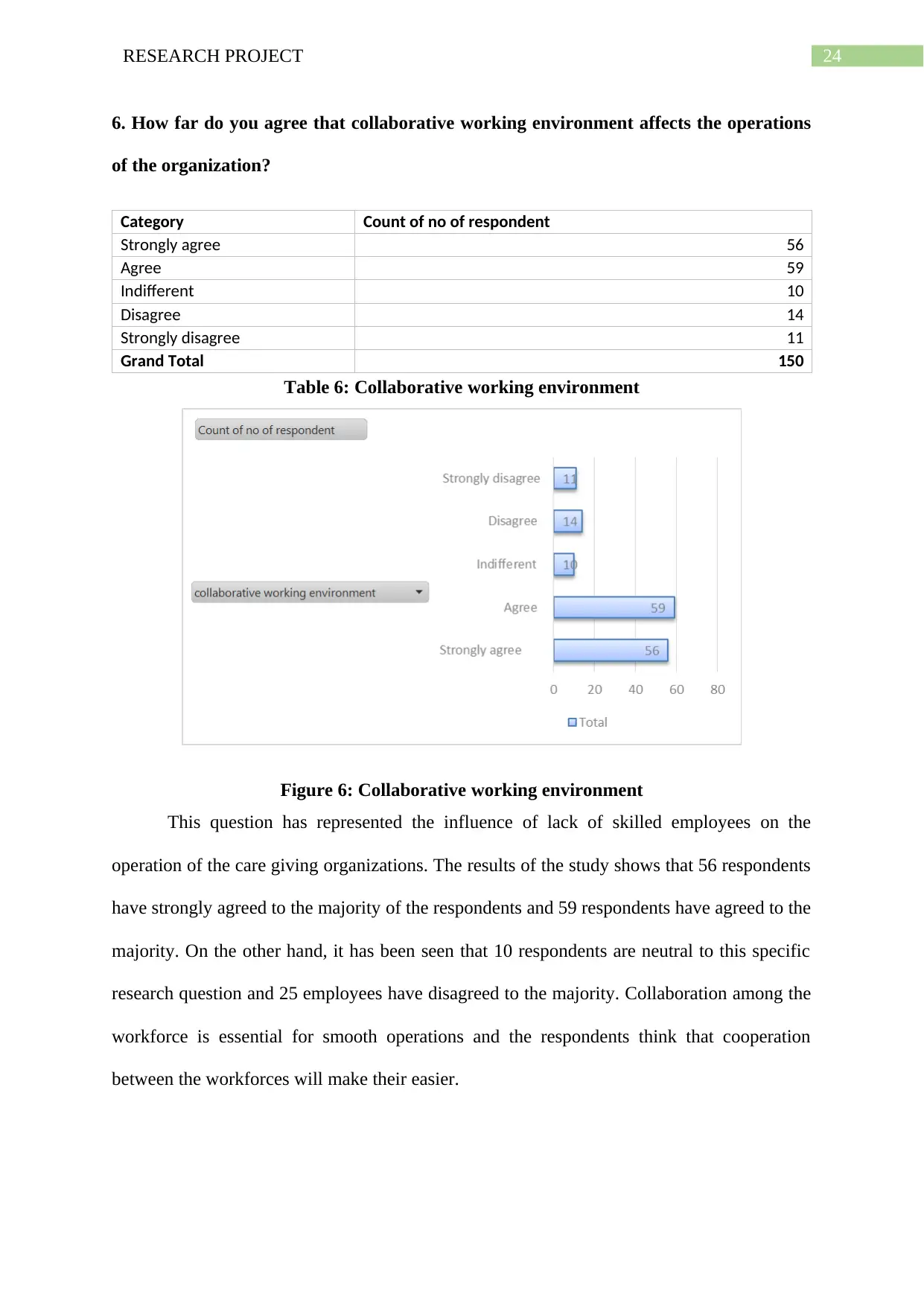
6. How far do you agree that collaborative working environment affects the operations
of the organization?
Category Count of no of respondent
Strongly agree 56
Agree 59
Indifferent 10
Disagree 14
Strongly disagree 11
Grand Total 150
Table 6: Collaborative working environment
Figure 6: Collaborative working environment
This question has represented the influence of lack of skilled employees on the
operation of the care giving organizations. The results of the study shows that 56 respondents
have strongly agreed to the majority of the respondents and 59 respondents have agreed to the
majority. On the other hand, it has been seen that 10 respondents are neutral to this specific
research question and 25 employees have disagreed to the majority. Collaboration among the
workforce is essential for smooth operations and the respondents think that cooperation
between the workforces will make their easier.
Paraphrase This Document

4.1.3 Questions on job satisfaction and job alternatives
7. How far do you agree that high job satisfaction is essential for managing turnover?
Category Count of no of respondent
Strongly agree 69
Agree 46
Indifferent 10
Disagree 16
Strongly disagree 9
Grand Total 150
Table 7: Job satisfaction
Figure 7: Job satisfaction
This question has analysed the effect of job satisfaction on turnover rate in care giving
organizations. The findings of the study shows that 69 respondents have strongly agreed to
the majority of the respondents and 46 respondents have agreed to the majority. On the other
hand, it has been seen that 10 respondents are neutral to this specific research question and 25
employees have disagreed to the majority. Job satisfaction is the one of the key components
of employee motivation among the employees and increase in job satisfaction will definitely
reduce the turnover rate.
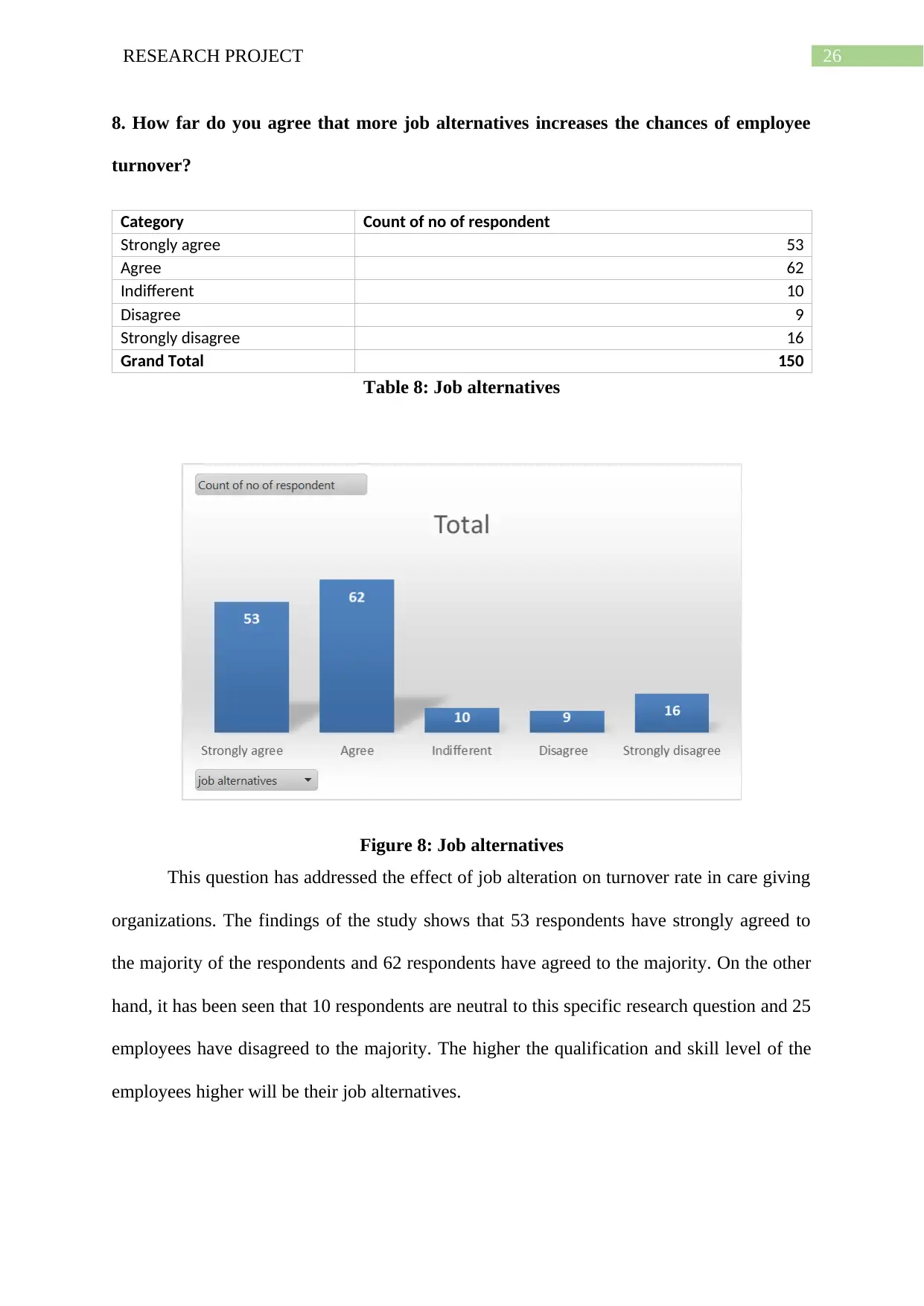
8. How far do you agree that more job alternatives increases the chances of employee
turnover?
Category Count of no of respondent
Strongly agree 53
Agree 62
Indifferent 10
Disagree 9
Strongly disagree 16
Grand Total 150
Table 8: Job alternatives
Figure 8: Job alternatives
This question has addressed the effect of job alteration on turnover rate in care giving
organizations. The findings of the study shows that 53 respondents have strongly agreed to
the majority of the respondents and 62 respondents have agreed to the majority. On the other
hand, it has been seen that 10 respondents are neutral to this specific research question and 25
employees have disagreed to the majority. The higher the qualification and skill level of the
employees higher will be their job alternatives.
⊘ This is a preview!⊘
Do you want full access?
Subscribe today to unlock all pages.

Trusted by 1+ million students worldwide
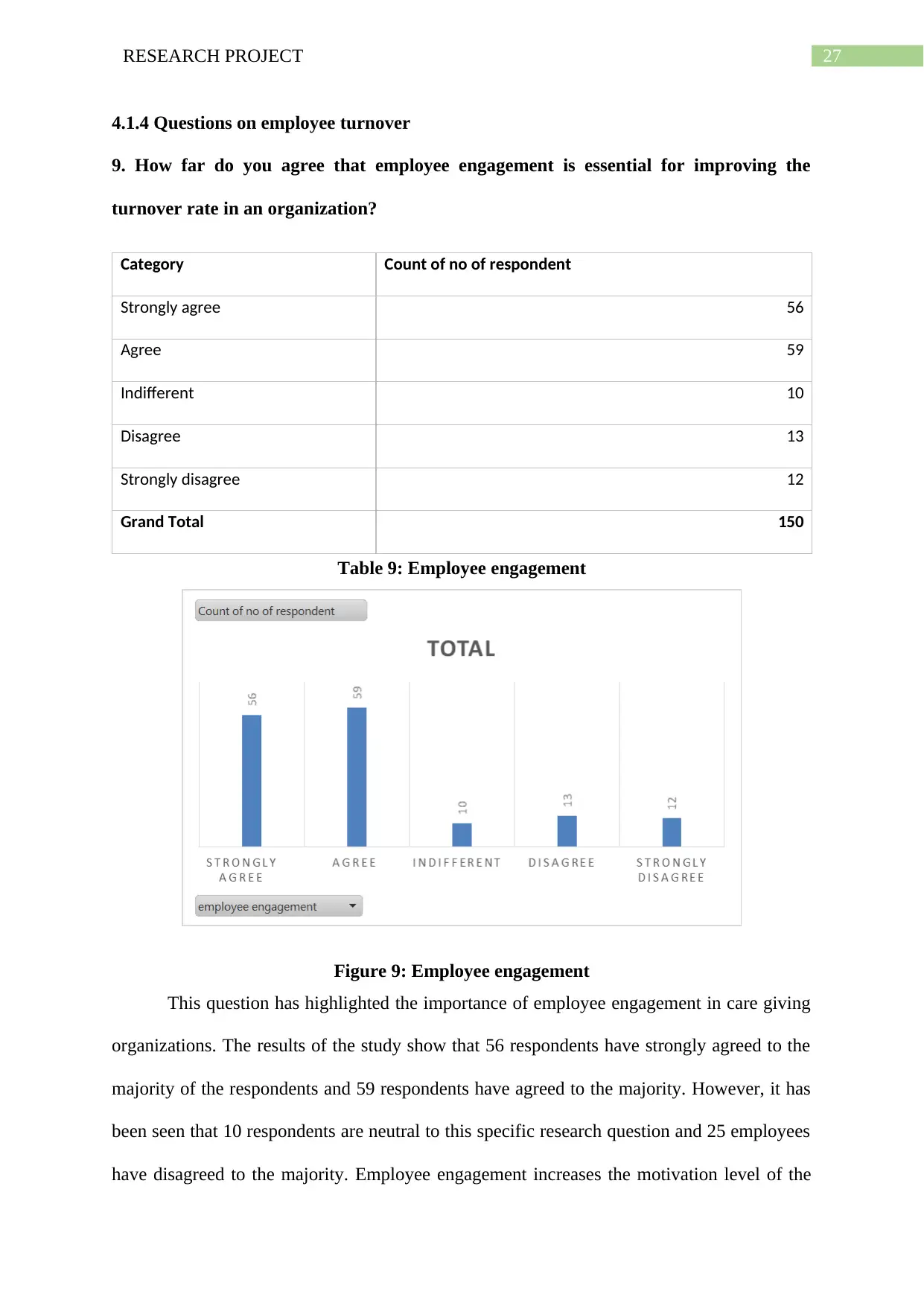
4.1.4 Questions on employee turnover
9. How far do you agree that employee engagement is essential for improving the
turnover rate in an organization?
Category Count of no of respondent
Strongly agree 56
Agree 59
Indifferent 10
Disagree 13
Strongly disagree 12
Grand Total 150
Table 9: Employee engagement
Figure 9: Employee engagement
This question has highlighted the importance of employee engagement in care giving
organizations. The results of the study show that 56 respondents have strongly agreed to the
majority of the respondents and 59 respondents have agreed to the majority. However, it has
been seen that 10 respondents are neutral to this specific research question and 25 employees
have disagreed to the majority. Employee engagement increases the motivation level of the
Paraphrase This Document
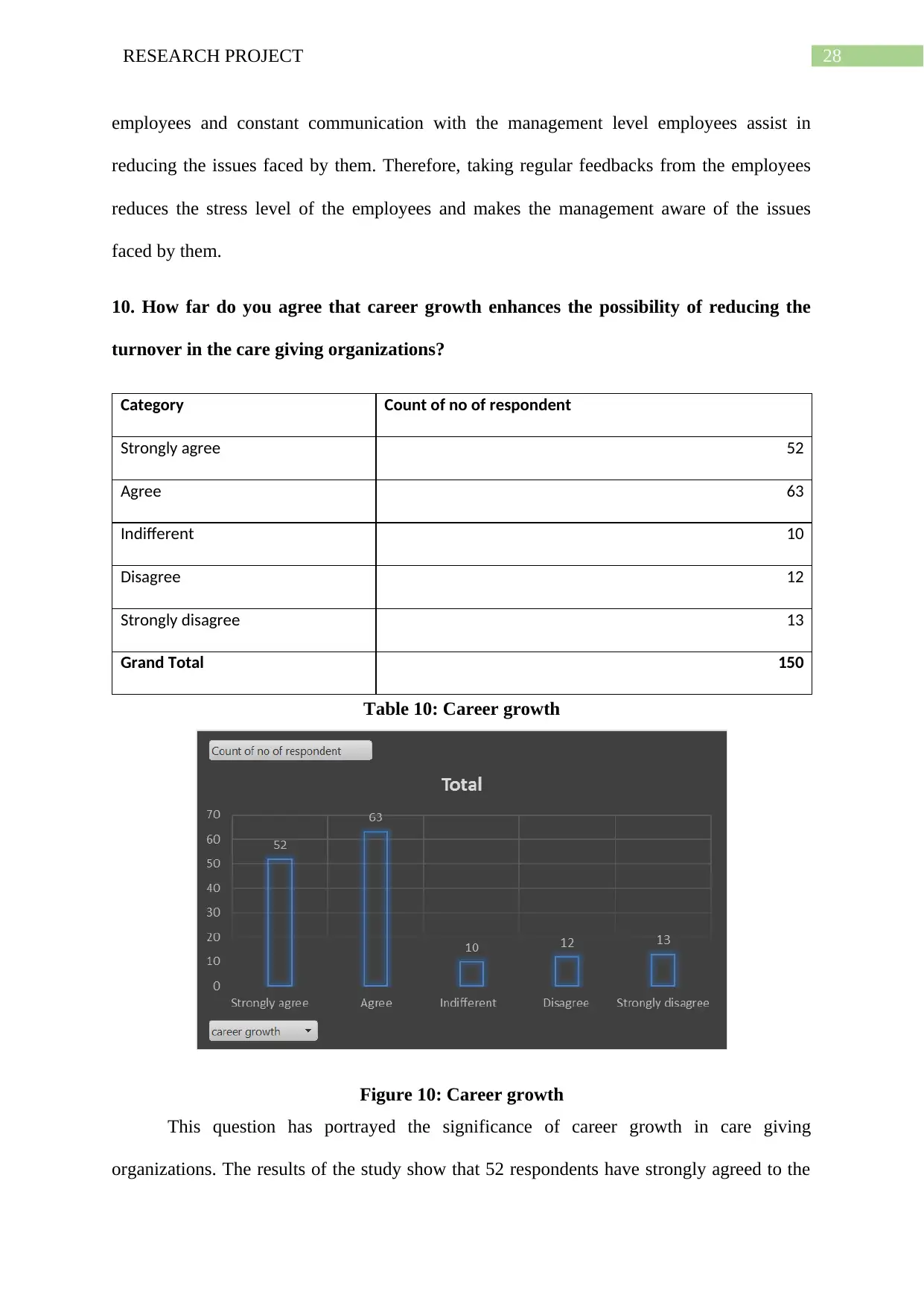
employees and constant communication with the management level employees assist in
reducing the issues faced by them. Therefore, taking regular feedbacks from the employees
reduces the stress level of the employees and makes the management aware of the issues
faced by them.
10. How far do you agree that career growth enhances the possibility of reducing the
turnover in the care giving organizations?
Category Count of no of respondent
Strongly agree 52
Agree 63
Indifferent 10
Disagree 12
Strongly disagree 13
Grand Total 150
Table 10: Career growth
Figure 10: Career growth
This question has portrayed the significance of career growth in care giving
organizations. The results of the study show that 52 respondents have strongly agreed to the
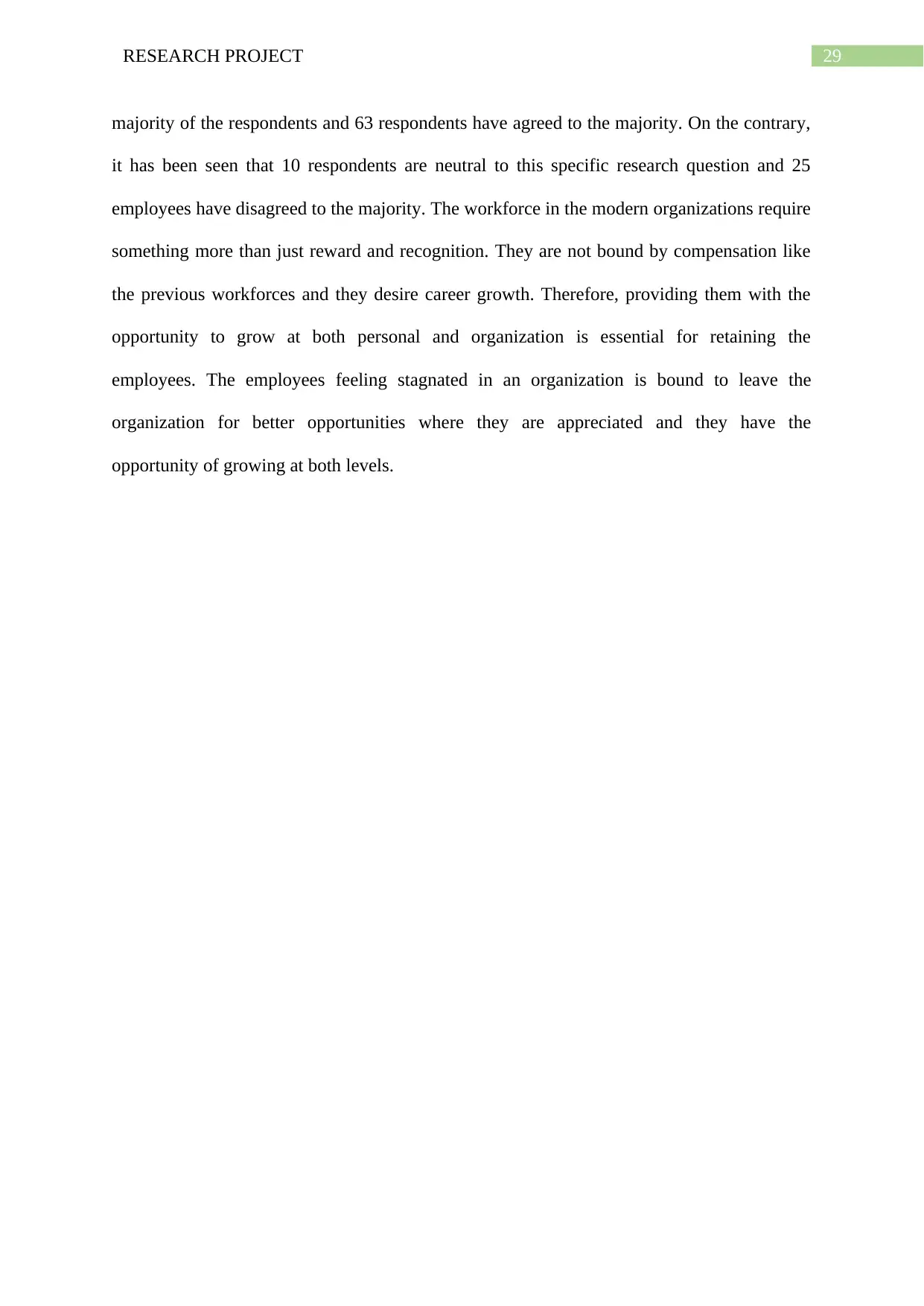
majority of the respondents and 63 respondents have agreed to the majority. On the contrary,
it has been seen that 10 respondents are neutral to this specific research question and 25
employees have disagreed to the majority. The workforce in the modern organizations require
something more than just reward and recognition. They are not bound by compensation like
the previous workforces and they desire career growth. Therefore, providing them with the
opportunity to grow at both personal and organization is essential for retaining the
employees. The employees feeling stagnated in an organization is bound to leave the
organization for better opportunities where they are appreciated and they have the
opportunity of growing at both levels.
⊘ This is a preview!⊘
Do you want full access?
Subscribe today to unlock all pages.

Trusted by 1+ million students worldwide
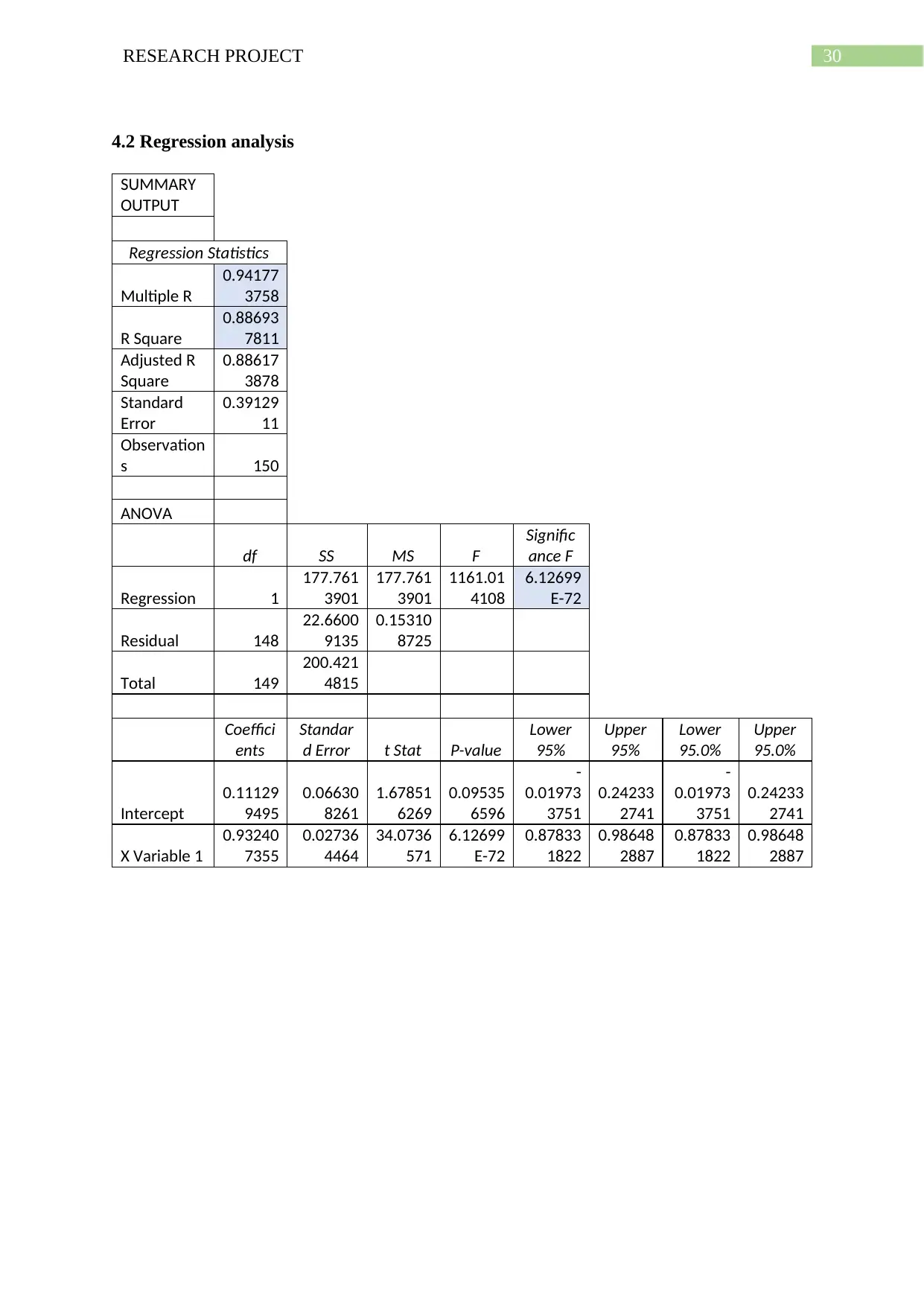
4.2 Regression analysis
SUMMARY
OUTPUT
Regression Statistics
Multiple R
0.94177
3758
R Square
0.88693
7811
Adjusted R
Square
0.88617
3878
Standard
Error
0.39129
11
Observation
s 150
ANOVA
df SS MS F
Signific
ance F
Regression 1
177.761
3901
177.761
3901
1161.01
4108
6.12699
E-72
Residual 148
22.6600
9135
0.15310
8725
Total 149
200.421
4815
Coeffici
ents
Standar
d Error t Stat P-value
Lower
95%
Upper
95%
Lower
95.0%
Upper
95.0%
Intercept
0.11129
9495
0.06630
8261
1.67851
6269
0.09535
6596
-
0.01973
3751
0.24233
2741
-
0.01973
3751
0.24233
2741
X Variable 1
0.93240
7355
0.02736
4464
34.0736
571
6.12699
E-72
0.87833
1822
0.98648
2887
0.87833
1822
0.98648
2887
Paraphrase This Document
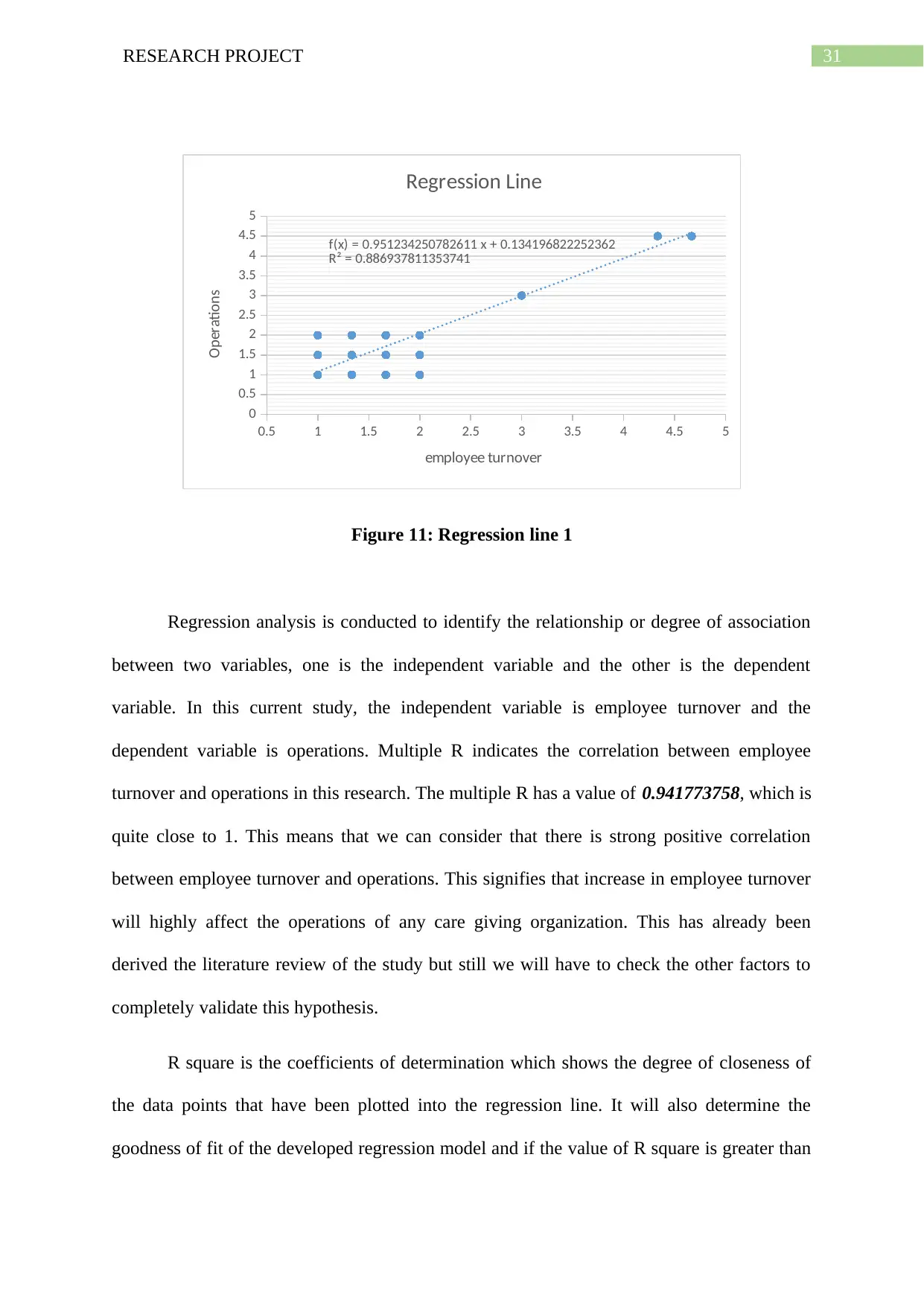
0.5 1 1.5 2 2.5 3 3.5 4 4.5 5
0
0.5
1
1.5
2
2.5
3
3.5
4
4.5
5
f(x) = 0.951234250782611 x + 0.134196822252362
R² = 0.886937811353741
Regression Line
employee turnover
Operations
Figure 11: Regression line 1
Regression analysis is conducted to identify the relationship or degree of association
between two variables, one is the independent variable and the other is the dependent
variable. In this current study, the independent variable is employee turnover and the
dependent variable is operations. Multiple R indicates the correlation between employee
turnover and operations in this research. The multiple R has a value of 0.941773758, which is
quite close to 1. This means that we can consider that there is strong positive correlation
between employee turnover and operations. This signifies that increase in employee turnover
will highly affect the operations of any care giving organization. This has already been
derived the literature review of the study but still we will have to check the other factors to
completely validate this hypothesis.
R square is the coefficients of determination which shows the degree of closeness of
the data points that have been plotted into the regression line. It will also determine the
goodness of fit of the developed regression model and if the value of R square is greater than
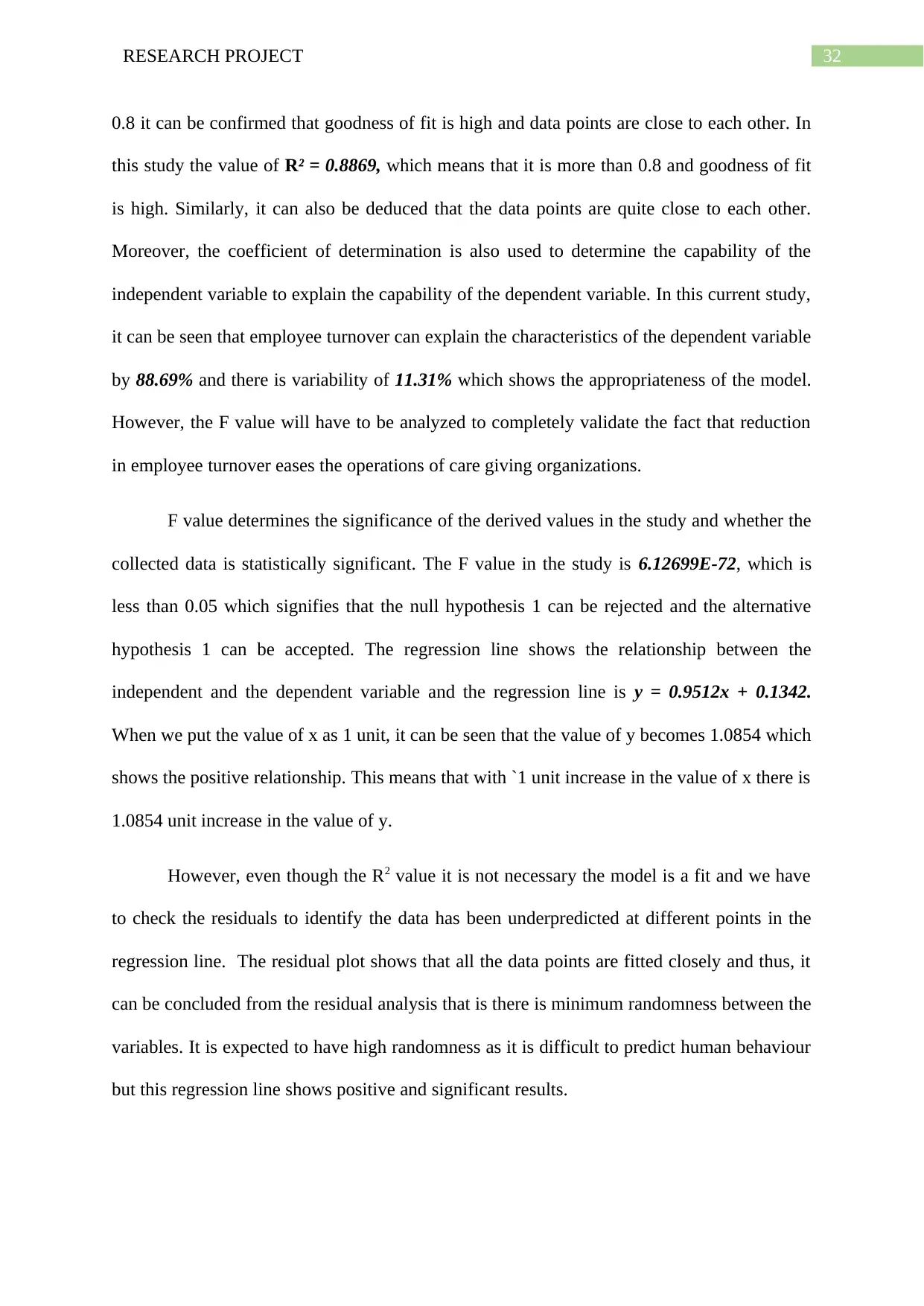
0.8 it can be confirmed that goodness of fit is high and data points are close to each other. In
this study the value of R² = 0.8869, which means that it is more than 0.8 and goodness of fit
is high. Similarly, it can also be deduced that the data points are quite close to each other.
Moreover, the coefficient of determination is also used to determine the capability of the
independent variable to explain the capability of the dependent variable. In this current study,
it can be seen that employee turnover can explain the characteristics of the dependent variable
by 88.69% and there is variability of 11.31% which shows the appropriateness of the model.
However, the F value will have to be analyzed to completely validate the fact that reduction
in employee turnover eases the operations of care giving organizations.
F value determines the significance of the derived values in the study and whether the
collected data is statistically significant. The F value in the study is 6.12699E-72, which is
less than 0.05 which signifies that the null hypothesis 1 can be rejected and the alternative
hypothesis 1 can be accepted. The regression line shows the relationship between the
independent and the dependent variable and the regression line is y = 0.9512x + 0.1342.
When we put the value of x as 1 unit, it can be seen that the value of y becomes 1.0854 which
shows the positive relationship. This means that with `1 unit increase in the value of x there is
1.0854 unit increase in the value of y.
However, even though the R2 value it is not necessary the model is a fit and we have
to check the residuals to identify the data has been underpredicted at different points in the
regression line. The residual plot shows that all the data points are fitted closely and thus, it
can be concluded from the residual analysis that is there is minimum randomness between the
variables. It is expected to have high randomness as it is difficult to predict human behaviour
but this regression line shows positive and significant results.
⊘ This is a preview!⊘
Do you want full access?
Subscribe today to unlock all pages.

Trusted by 1+ million students worldwide
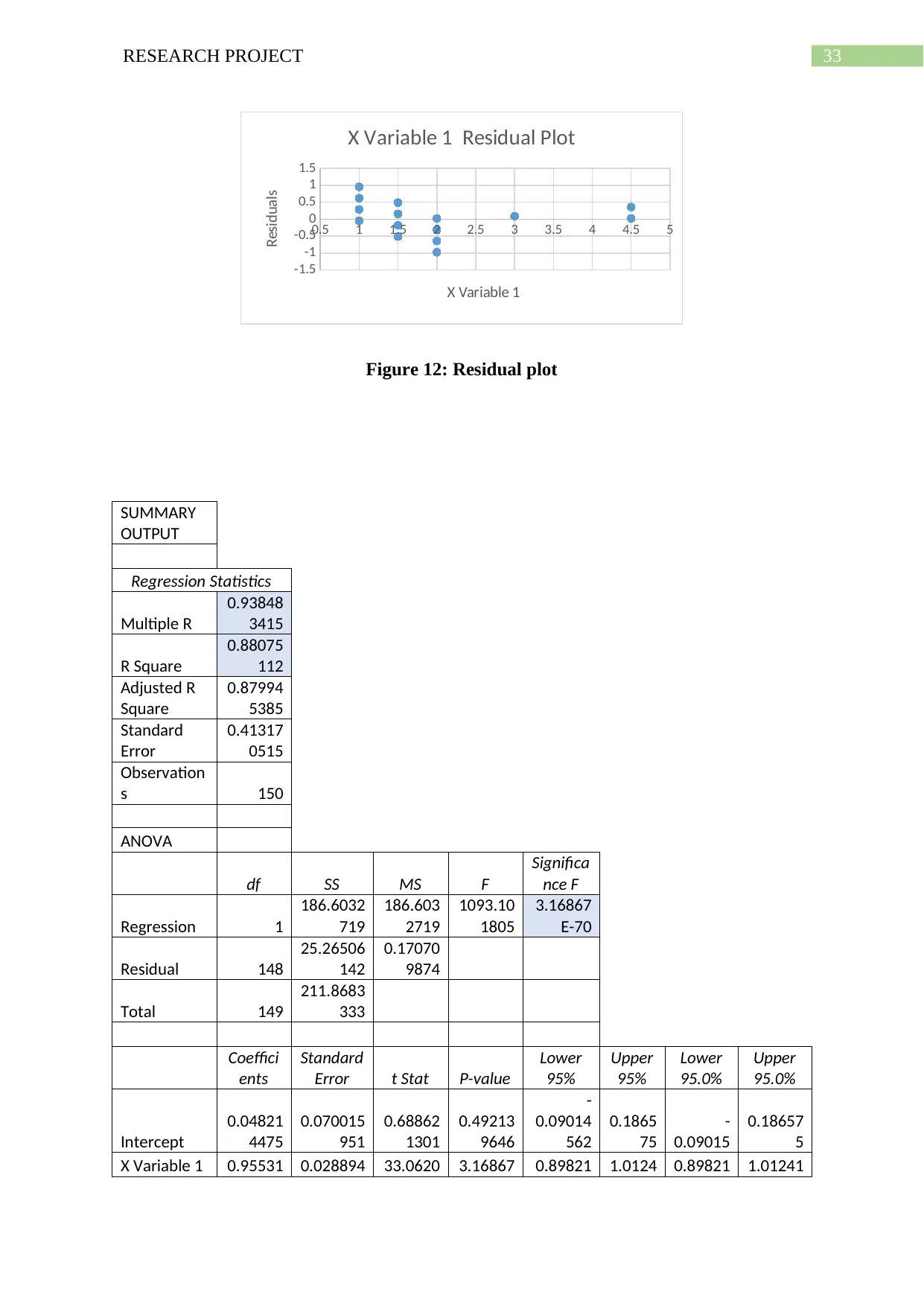
0.5 1 1.5 2 2.5 3 3.5 4 4.5 5
-1.5
-1
-0.5
0
0.5
1
1.5
X Variable 1 Residual Plot
X Variable 1
Residuals
Figure 12: Residual plot
SUMMARY
OUTPUT
Regression Statistics
Multiple R
0.93848
3415
R Square
0.88075
112
Adjusted R
Square
0.87994
5385
Standard
Error
0.41317
0515
Observation
s 150
ANOVA
df SS MS F
Significa
nce F
Regression 1
186.6032
719
186.603
2719
1093.10
1805
3.16867
E-70
Residual 148
25.26506
142
0.17070
9874
Total 149
211.8683
333
Coeffici
ents
Standard
Error t Stat P-value
Lower
95%
Upper
95%
Lower
95.0%
Upper
95.0%
Intercept
0.04821
4475
0.070015
951
0.68862
1301
0.49213
9646
-
0.09014
562
0.1865
75
-
0.09015
0.18657
5
X Variable 1 0.95531 0.028894 33.0620 3.16867 0.89821 1.0124 0.89821 1.01241
Paraphrase This Document
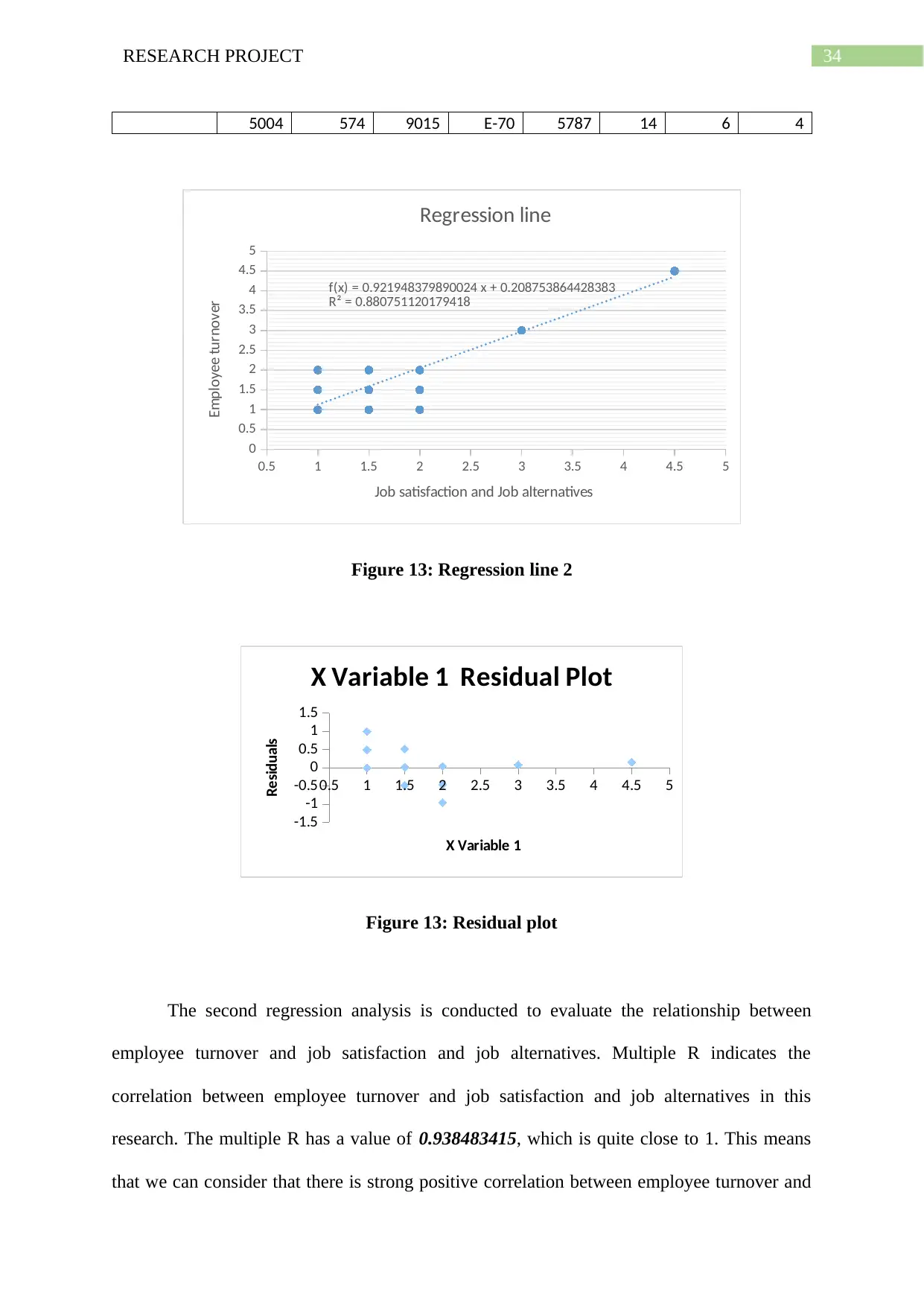
5004 574 9015 E-70 5787 14 6 4
0.5 1 1.5 2 2.5 3 3.5 4 4.5 5
0
0.5
1
1.5
2
2.5
3
3.5
4
4.5
5
f(x) = 0.921948379890024 x + 0.208753864428383
R² = 0.880751120179418
Regression line
Job satisfaction and Job alternatives
Employee turnover
Figure 13: Regression line 2
0.5 1 1.5 2 2.5 3 3.5 4 4.5 5
-1.5
-1
-0.5
0
0.5
1
1.5
X Variable 1 Residual Plot
X Variable 1
Residuals
Figure 13: Residual plot
The second regression analysis is conducted to evaluate the relationship between
employee turnover and job satisfaction and job alternatives. Multiple R indicates the
correlation between employee turnover and job satisfaction and job alternatives in this
research. The multiple R has a value of 0.938483415, which is quite close to 1. This means
that we can consider that there is strong positive correlation between employee turnover and
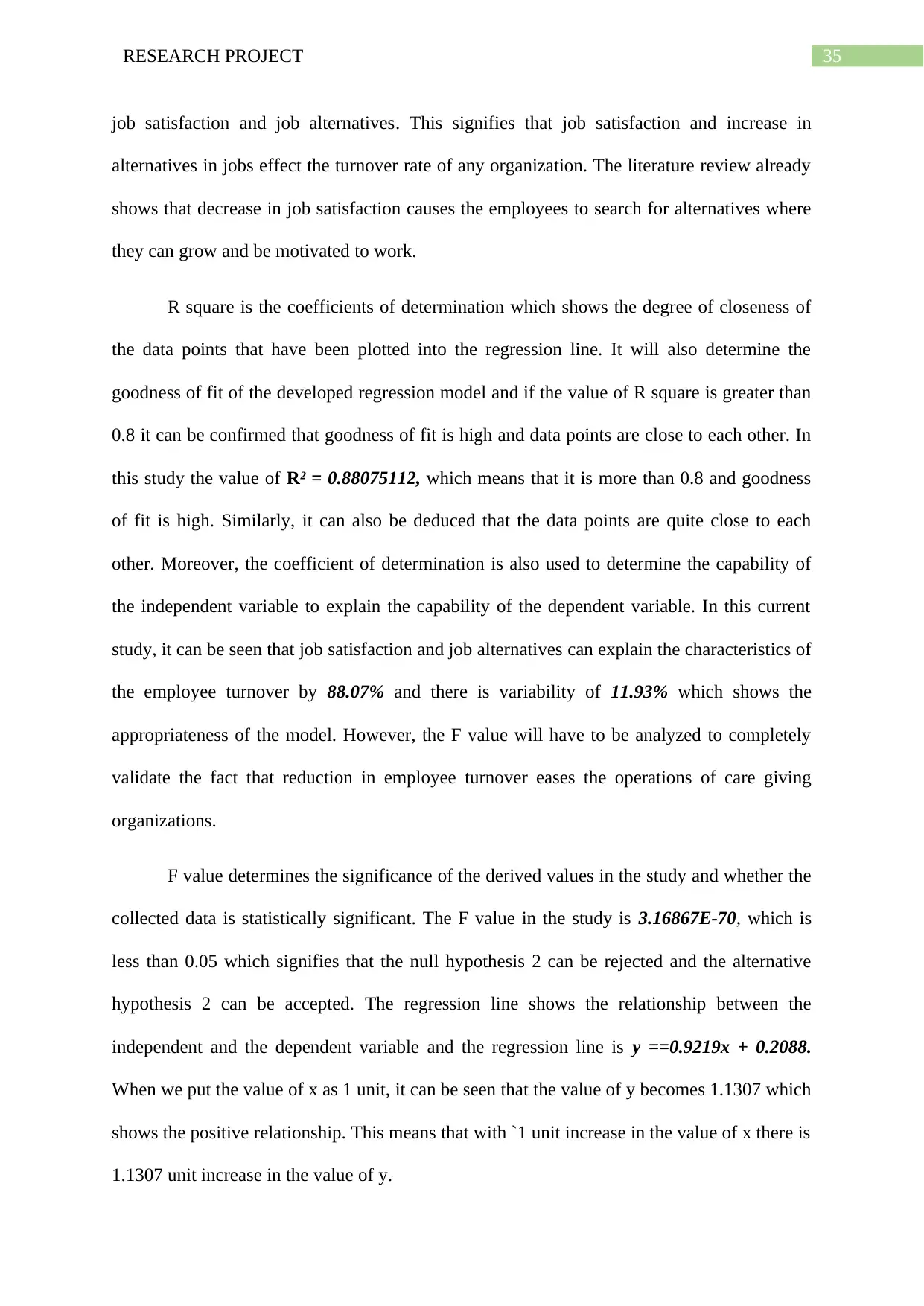
job satisfaction and job alternatives. This signifies that job satisfaction and increase in
alternatives in jobs effect the turnover rate of any organization. The literature review already
shows that decrease in job satisfaction causes the employees to search for alternatives where
they can grow and be motivated to work.
R square is the coefficients of determination which shows the degree of closeness of
the data points that have been plotted into the regression line. It will also determine the
goodness of fit of the developed regression model and if the value of R square is greater than
0.8 it can be confirmed that goodness of fit is high and data points are close to each other. In
this study the value of R² = 0.88075112, which means that it is more than 0.8 and goodness
of fit is high. Similarly, it can also be deduced that the data points are quite close to each
other. Moreover, the coefficient of determination is also used to determine the capability of
the independent variable to explain the capability of the dependent variable. In this current
study, it can be seen that job satisfaction and job alternatives can explain the characteristics of
the employee turnover by 88.07% and there is variability of 11.93% which shows the
appropriateness of the model. However, the F value will have to be analyzed to completely
validate the fact that reduction in employee turnover eases the operations of care giving
organizations.
F value determines the significance of the derived values in the study and whether the
collected data is statistically significant. The F value in the study is 3.16867E-70, which is
less than 0.05 which signifies that the null hypothesis 2 can be rejected and the alternative
hypothesis 2 can be accepted. The regression line shows the relationship between the
independent and the dependent variable and the regression line is y ==0.9219x + 0.2088.
When we put the value of x as 1 unit, it can be seen that the value of y becomes 1.1307 which
shows the positive relationship. This means that with `1 unit increase in the value of x there is
1.1307 unit increase in the value of y.
⊘ This is a preview!⊘
Do you want full access?
Subscribe today to unlock all pages.

Trusted by 1+ million students worldwide
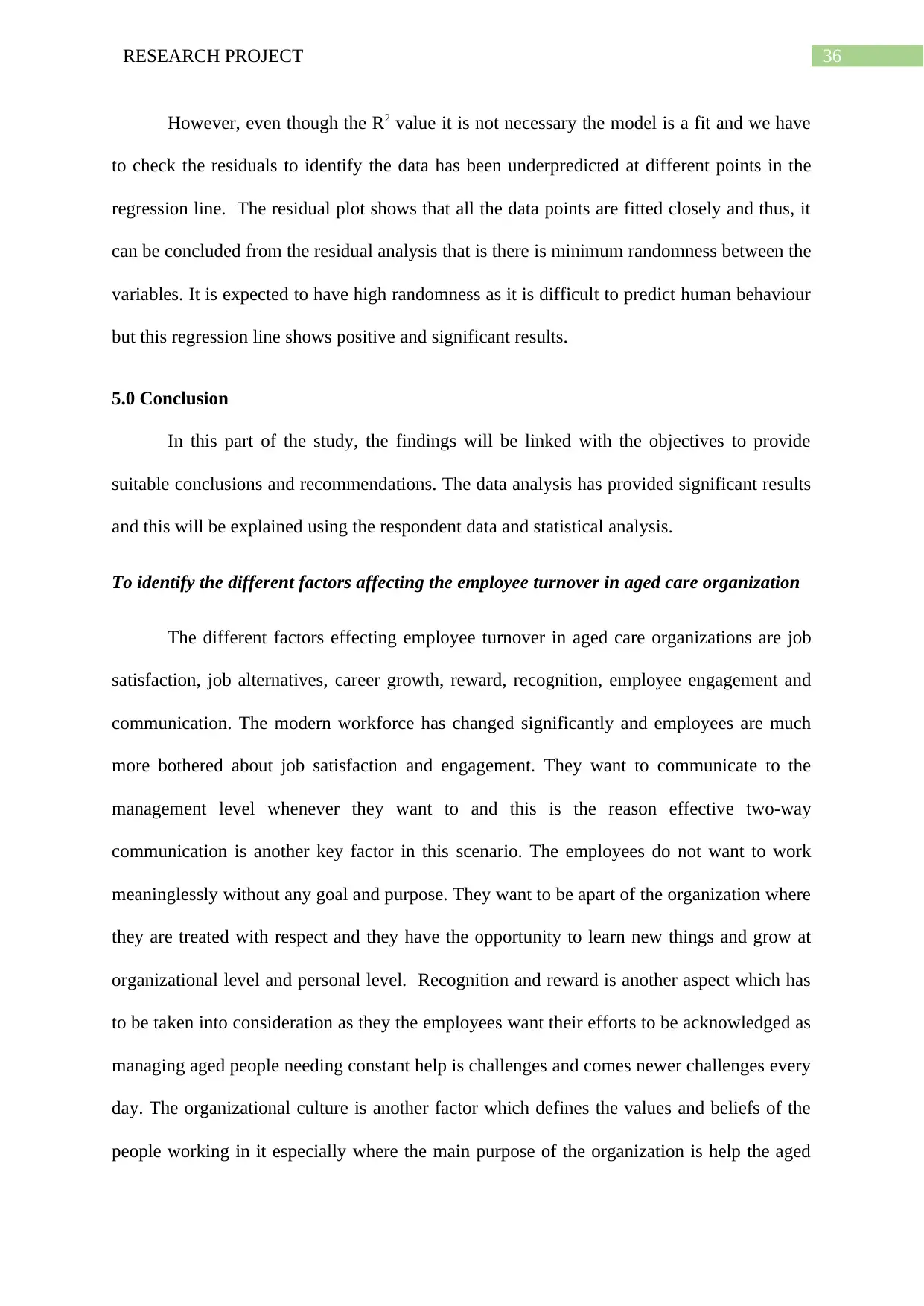
However, even though the R2 value it is not necessary the model is a fit and we have
to check the residuals to identify the data has been underpredicted at different points in the
regression line. The residual plot shows that all the data points are fitted closely and thus, it
can be concluded from the residual analysis that is there is minimum randomness between the
variables. It is expected to have high randomness as it is difficult to predict human behaviour
but this regression line shows positive and significant results.
5.0 Conclusion
In this part of the study, the findings will be linked with the objectives to provide
suitable conclusions and recommendations. The data analysis has provided significant results
and this will be explained using the respondent data and statistical analysis.
To identify the different factors affecting the employee turnover in aged care organization
The different factors effecting employee turnover in aged care organizations are job
satisfaction, job alternatives, career growth, reward, recognition, employee engagement and
communication. The modern workforce has changed significantly and employees are much
more bothered about job satisfaction and engagement. They want to communicate to the
management level whenever they want to and this is the reason effective two-way
communication is another key factor in this scenario. The employees do not want to work
meaninglessly without any goal and purpose. They want to be apart of the organization where
they are treated with respect and they have the opportunity to learn new things and grow at
organizational level and personal level. Recognition and reward is another aspect which has
to be taken into consideration as they the employees want their efforts to be acknowledged as
managing aged people needing constant help is challenges and comes newer challenges every
day. The organizational culture is another factor which defines the values and beliefs of the
people working in it especially where the main purpose of the organization is help the aged
Paraphrase This Document
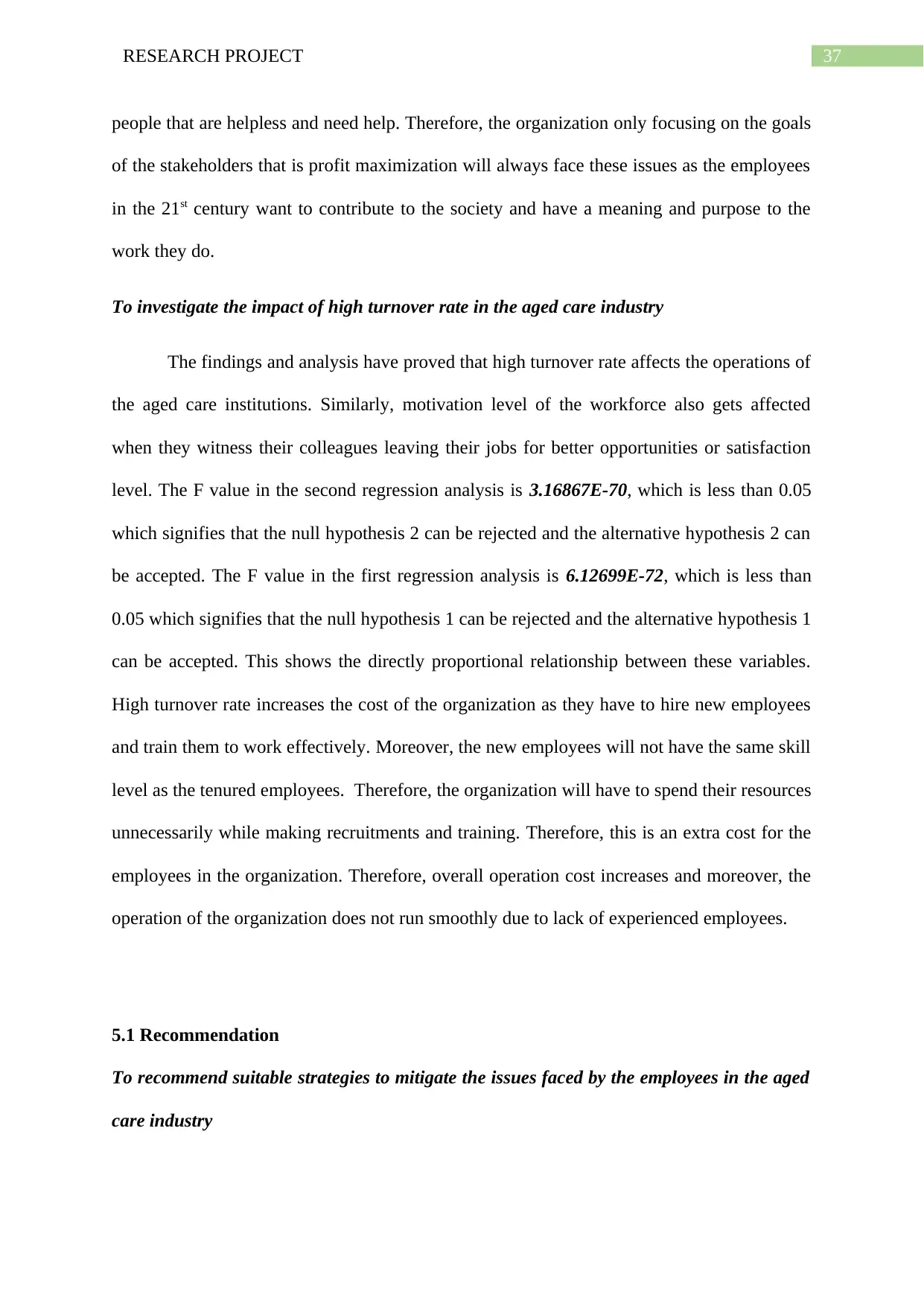
people that are helpless and need help. Therefore, the organization only focusing on the goals
of the stakeholders that is profit maximization will always face these issues as the employees
in the 21st century want to contribute to the society and have a meaning and purpose to the
work they do.
To investigate the impact of high turnover rate in the aged care industry
The findings and analysis have proved that high turnover rate affects the operations of
the aged care institutions. Similarly, motivation level of the workforce also gets affected
when they witness their colleagues leaving their jobs for better opportunities or satisfaction
level. The F value in the second regression analysis is 3.16867E-70, which is less than 0.05
which signifies that the null hypothesis 2 can be rejected and the alternative hypothesis 2 can
be accepted. The F value in the first regression analysis is 6.12699E-72, which is less than
0.05 which signifies that the null hypothesis 1 can be rejected and the alternative hypothesis 1
can be accepted. This shows the directly proportional relationship between these variables.
High turnover rate increases the cost of the organization as they have to hire new employees
and train them to work effectively. Moreover, the new employees will not have the same skill
level as the tenured employees. Therefore, the organization will have to spend their resources
unnecessarily while making recruitments and training. Therefore, this is an extra cost for the
employees in the organization. Therefore, overall operation cost increases and moreover, the
operation of the organization does not run smoothly due to lack of experienced employees.
5.1 Recommendation
To recommend suitable strategies to mitigate the issues faced by the employees in the aged
care industry

The research has concluded that proper working conditions, support and
organizational culture are the focus for the organizations in the care giving industry. The
supervisors and managers will have to support the employees so that they intend to stay and
provide them with help at all times so that they can share their issues. This consist of holding
regular meetings where the different issues and challenges faced by the employees in the
organization will be discussed. Moreover, employers should invest in training employees
including leadership programs which provides them with the opportunity of changing their
roles in the same organization without any change of organizational setting. The organization
will have to give importance to the feelings of the employees and develop an organizational
culture which is diverse and helps in nurturing a better environment for the workforce.
Moreover, the above factors such as career growth, rewards and recognition are other factors
which has to be focused on as retaining younger workers requires focus on these factors.
⊘ This is a preview!⊘
Do you want full access?
Subscribe today to unlock all pages.

Trusted by 1+ million students worldwide
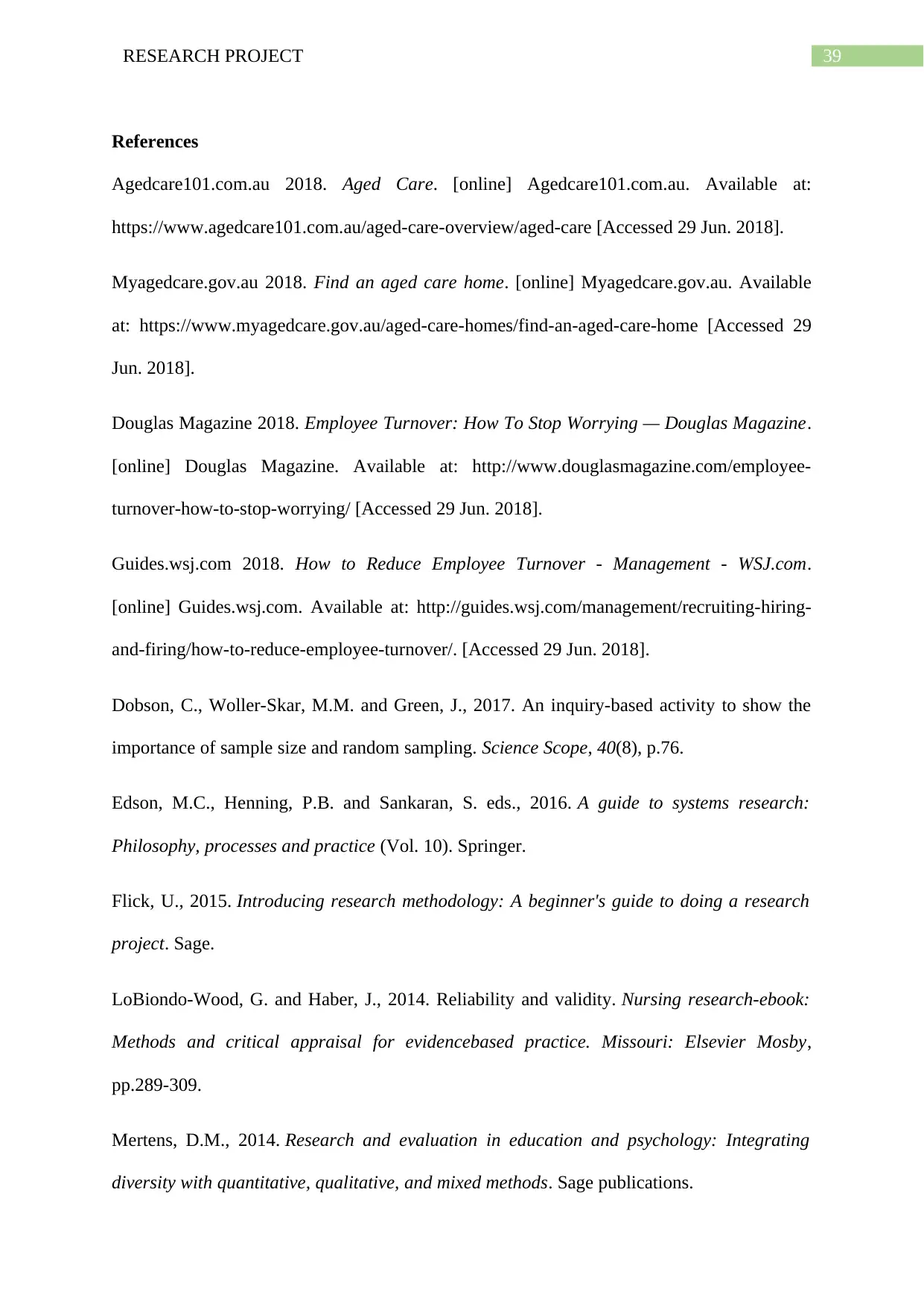
References
Agedcare101.com.au 2018. Aged Care. [online] Agedcare101.com.au. Available at:
https://www.agedcare101.com.au/aged-care-overview/aged-care [Accessed 29 Jun. 2018].
Myagedcare.gov.au 2018. Find an aged care home. [online] Myagedcare.gov.au. Available
at: https://www.myagedcare.gov.au/aged-care-homes/find-an-aged-care-home [Accessed 29
Jun. 2018].
Douglas Magazine 2018. Employee Turnover: How To Stop Worrying — Douglas Magazine.
[online] Douglas Magazine. Available at: http://www.douglasmagazine.com/employee-
turnover-how-to-stop-worrying/ [Accessed 29 Jun. 2018].
Guides.wsj.com 2018. How to Reduce Employee Turnover - Management - WSJ.com.
[online] Guides.wsj.com. Available at: http://guides.wsj.com/management/recruiting-hiring-
and-firing/how-to-reduce-employee-turnover/. [Accessed 29 Jun. 2018].
Dobson, C., Woller-Skar, M.M. and Green, J., 2017. An inquiry-based activity to show the
importance of sample size and random sampling. Science Scope, 40(8), p.76.
Edson, M.C., Henning, P.B. and Sankaran, S. eds., 2016. A guide to systems research:
Philosophy, processes and practice (Vol. 10). Springer.
Flick, U., 2015. Introducing research methodology: A beginner's guide to doing a research
project. Sage.
LoBiondo-Wood, G. and Haber, J., 2014. Reliability and validity. Nursing research-ebook:
Methods and critical appraisal for evidencebased practice. Missouri: Elsevier Mosby,
pp.289-309.
Mertens, D.M., 2014. Research and evaluation in education and psychology: Integrating
diversity with quantitative, qualitative, and mixed methods. Sage publications.
Paraphrase This Document
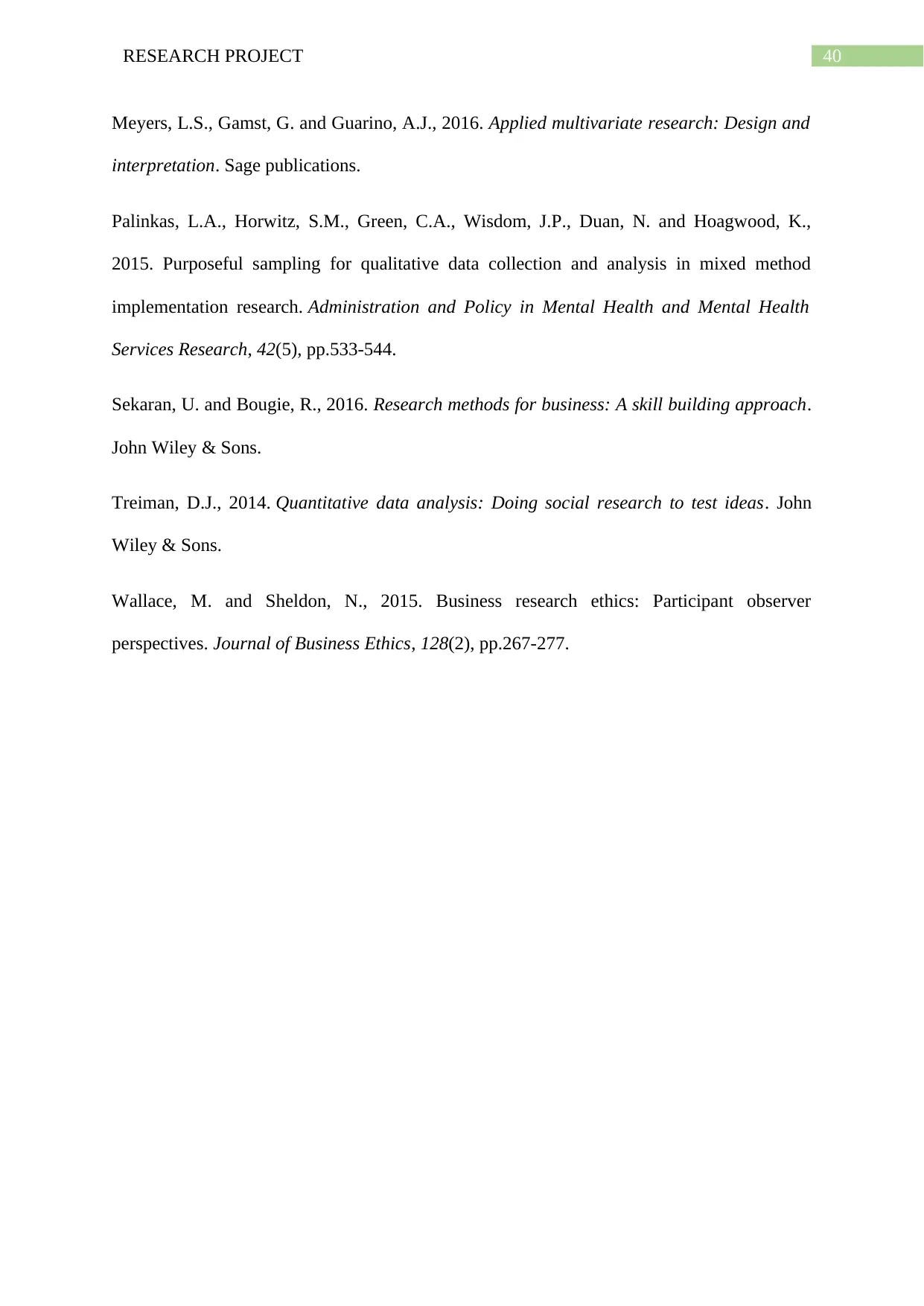
Meyers, L.S., Gamst, G. and Guarino, A.J., 2016. Applied multivariate research: Design and
interpretation. Sage publications.
Palinkas, L.A., Horwitz, S.M., Green, C.A., Wisdom, J.P., Duan, N. and Hoagwood, K.,
2015. Purposeful sampling for qualitative data collection and analysis in mixed method
implementation research. Administration and Policy in Mental Health and Mental Health
Services Research, 42(5), pp.533-544.
Sekaran, U. and Bougie, R., 2016. Research methods for business: A skill building approach.
John Wiley & Sons.
Treiman, D.J., 2014. Quantitative data analysis: Doing social research to test ideas. John
Wiley & Sons.
Wallace, M. and Sheldon, N., 2015. Business research ethics: Participant observer
perspectives. Journal of Business Ethics, 128(2), pp.267-277.
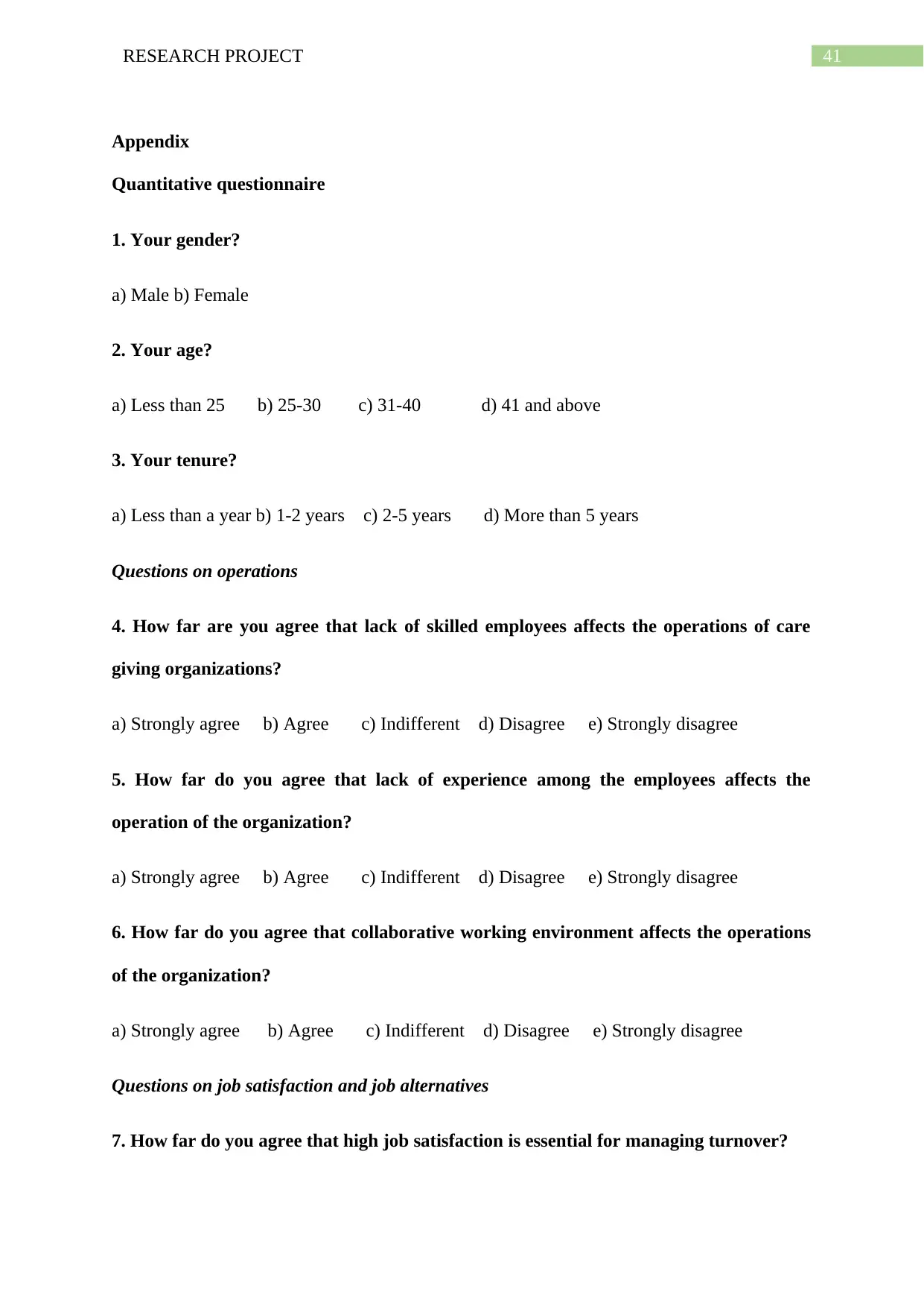
Appendix
Quantitative questionnaire
1. Your gender?
a) Male b) Female
2. Your age?
a) Less than 25 b) 25-30 c) 31-40 d) 41 and above
3. Your tenure?
a) Less than a year b) 1-2 years c) 2-5 years d) More than 5 years
Questions on operations
4. How far are you agree that lack of skilled employees affects the operations of care
giving organizations?
a) Strongly agree b) Agree c) Indifferent d) Disagree e) Strongly disagree
5. How far do you agree that lack of experience among the employees affects the
operation of the organization?
a) Strongly agree b) Agree c) Indifferent d) Disagree e) Strongly disagree
6. How far do you agree that collaborative working environment affects the operations
of the organization?
a) Strongly agree b) Agree c) Indifferent d) Disagree e) Strongly disagree
Questions on job satisfaction and job alternatives
7. How far do you agree that high job satisfaction is essential for managing turnover?
⊘ This is a preview!⊘
Do you want full access?
Subscribe today to unlock all pages.

Trusted by 1+ million students worldwide
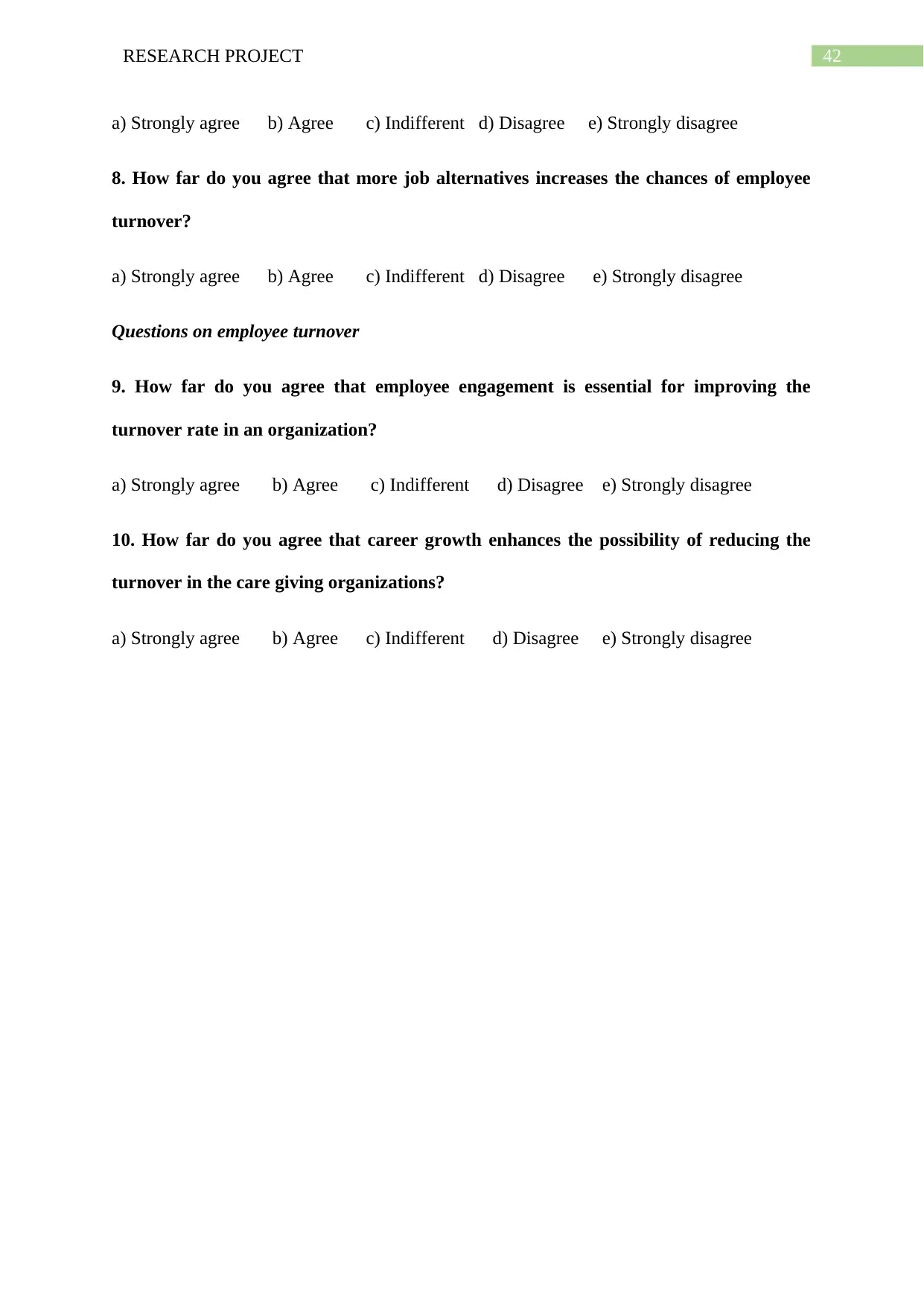
a) Strongly agree b) Agree c) Indifferent d) Disagree e) Strongly disagree
8. How far do you agree that more job alternatives increases the chances of employee
turnover?
a) Strongly agree b) Agree c) Indifferent d) Disagree e) Strongly disagree
Questions on employee turnover
9. How far do you agree that employee engagement is essential for improving the
turnover rate in an organization?
a) Strongly agree b) Agree c) Indifferent d) Disagree e) Strongly disagree
10. How far do you agree that career growth enhances the possibility of reducing the
turnover in the care giving organizations?
a) Strongly agree b) Agree c) Indifferent d) Disagree e) Strongly disagree
Related Documents
Your All-in-One AI-Powered Toolkit for Academic Success.
+13062052269
info@desklib.com
Available 24*7 on WhatsApp / Email
![[object Object]](/_next/static/media/star-bottom.7253800d.svg)
© 2024 | Zucol Services PVT LTD | All rights reserved.





